
Third Quarter 2021 Earnings Conference Call Bill Rogers – CEO Daryl Bible – CFO October 15, 2021
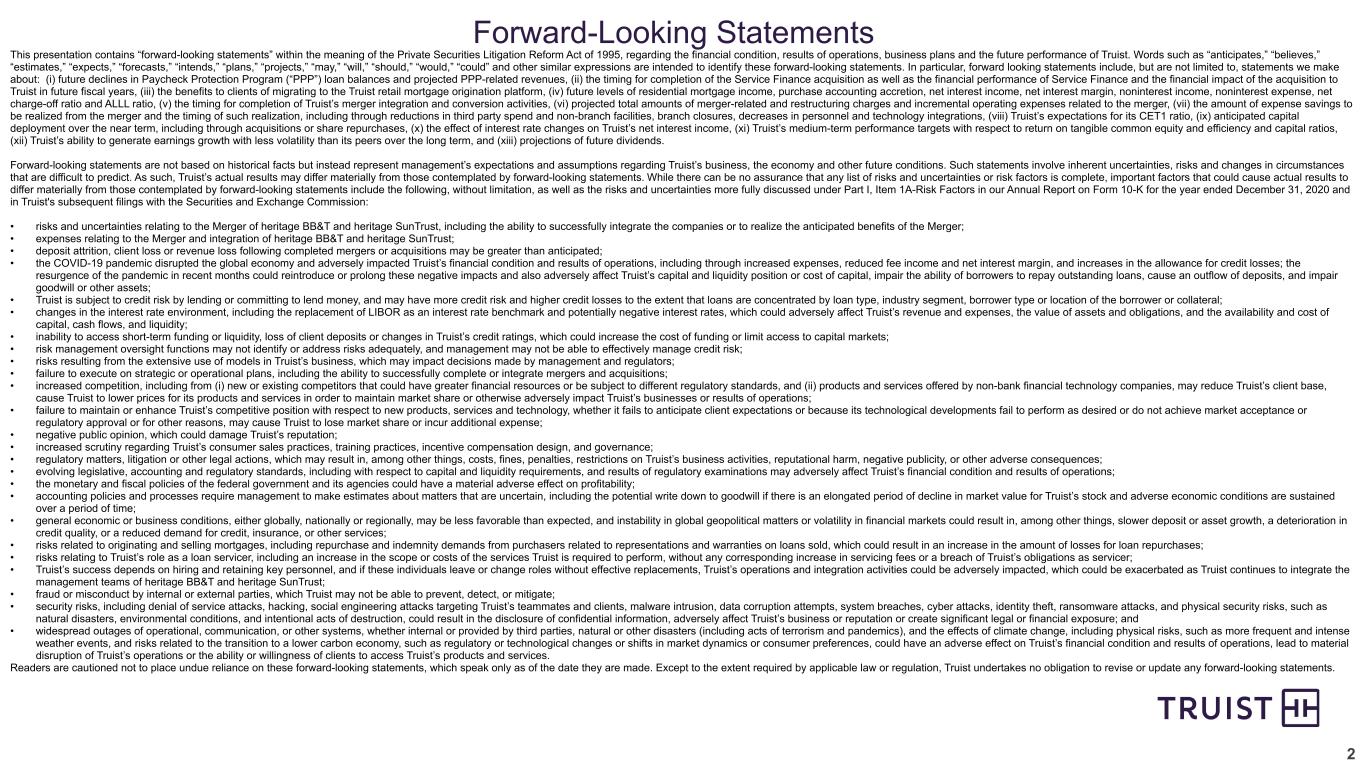
2 This presentation contains “forward-looking statements” within the meaning of the Private Securities Litigation Reform Act of 1995, regarding the financial condition, results of operations, business plans and the future performance of Truist. Words such as “anticipates,” “believes,” “estimates,” “expects,” “forecasts,” “intends,” “plans,” “projects,” “may,” “will,” “should,” “would,” “could” and other similar expressions are intended to identify these forward-looking statements. In particular, forward looking statements include, but are not limited to, statements we make about: (i) future declines in Paycheck Protection Program (“PPP”) loan balances and projected PPP-related revenues, (ii) the timing for completion of the Service Finance acquisition as well as the financial performance of Service Finance and the financial impact of the acquisition to Truist in future fiscal years, (iii) the benefits to clients of migrating to the Truist retail mortgage origination platform, (iv) future levels of residential mortgage income, purchase accounting accretion, net interest income, net interest margin, noninterest income, noninterest expense, net charge-off ratio and ALLL ratio, (v) the timing for completion of Truist’s merger integration and conversion activities, (vi) projected total amounts of merger-related and restructuring charges and incremental operating expenses related to the merger, (vii) the amount of expense savings to be realized from the merger and the timing of such realization, including through reductions in third party spend and non-branch facilities, branch closures, decreases in personnel and technology integrations, (viii) Truist’s expectations for its CET1 ratio, (ix) anticipated capital deployment over the near term, including through acquisitions or share repurchases, (x) the effect of interest rate changes on Truist’s net interest income, (xi) Truist’s medium-term performance targets with respect to return on tangible common equity and efficiency and capital ratios, (xii) Truist’s ability to generate earnings growth with less volatility than its peers over the long term, and (xiii) projections of future dividends. Forward-looking statements are not based on historical facts but instead represent management’s expectations and assumptions regarding Truist’s business, the economy and other future conditions. Such statements involve inherent uncertainties, risks and changes in circumstances that are difficult to predict. As such, Truist’s actual results may differ materially from those contemplated by forward-looking statements. While there can be no assurance that any list of risks and uncertainties or risk factors is complete, important factors that could cause actual results to differ materially from those contemplated by forward-looking statements include the following, without limitation, as well as the risks and uncertainties more fully discussed under Part I, Item 1A-Risk Factors in our Annual Report on Form 10-K for the year ended December 31, 2020 and in Truist's subsequent filings with the Securities and Exchange Commission: • risks and uncertainties relating to the Merger of heritage BB&T and heritage SunTrust, including the ability to successfully integrate the companies or to realize the anticipated benefits of the Merger; • expenses relating to the Merger and integration of heritage BB&T and heritage SunTrust; • deposit attrition, client loss or revenue loss following completed mergers or acquisitions may be greater than anticipated; • the COVID-19 pandemic disrupted the global economy and adversely impacted Truist’s financial condition and results of operations, including through increased expenses, reduced fee income and net interest margin, and increases in the allowance for credit losses; the resurgence of the pandemic in recent months could reintroduce or prolong these negative impacts and also adversely affect Truist’s capital and liquidity position or cost of capital, impair the ability of borrowers to repay outstanding loans, cause an outflow of deposits, and impair goodwill or other assets; • Truist is subject to credit risk by lending or committing to lend money, and may have more credit risk and higher credit losses to the extent that loans are concentrated by loan type, industry segment, borrower type or location of the borrower or collateral; • changes in the interest rate environment, including the replacement of LIBOR as an interest rate benchmark and potentially negative interest rates, which could adversely affect Truist’s revenue and expenses, the value of assets and obligations, and the availability and cost of capital, cash flows, and liquidity; • inability to access short-term funding or liquidity, loss of client deposits or changes in Truist’s credit ratings, which could increase the cost of funding or limit access to capital markets; • risk management oversight functions may not identify or address risks adequately, and management may not be able to effectively manage credit risk; • risks resulting from the extensive use of models in Truist’s business, which may impact decisions made by management and regulators; • failure to execute on strategic or operational plans, including the ability to successfully complete or integrate mergers and acquisitions; • increased competition, including from (i) new or existing competitors that could have greater financial resources or be subject to different regulatory standards, and (ii) products and services offered by non-bank financial technology companies, may reduce Truist’s client base, cause Truist to lower prices for its products and services in order to maintain market share or otherwise adversely impact Truist’s businesses or results of operations; • failure to maintain or enhance Truist’s competitive position with respect to new products, services and technology, whether it fails to anticipate client expectations or because its technological developments fail to perform as desired or do not achieve market acceptance or regulatory approval or for other reasons, may cause Truist to lose market share or incur additional expense; • negative public opinion, which could damage Truist’s reputation; • increased scrutiny regarding Truist’s consumer sales practices, training practices, incentive compensation design, and governance; • regulatory matters, litigation or other legal actions, which may result in, among other things, costs, fines, penalties, restrictions on Truist’s business activities, reputational harm, negative publicity, or other adverse consequences; • evolving legislative, accounting and regulatory standards, including with respect to capital and liquidity requirements, and results of regulatory examinations may adversely affect Truist’s financial condition and results of operations; • the monetary and fiscal policies of the federal government and its agencies could have a material adverse effect on profitability; • accounting policies and processes require management to make estimates about matters that are uncertain, including the potential write down to goodwill if there is an elongated period of decline in market value for Truist’s stock and adverse economic conditions are sustained over a period of time; • general economic or business conditions, either globally, nationally or regionally, may be less favorable than expected, and instability in global geopolitical matters or volatility in financial markets could result in, among other things, slower deposit or asset growth, a deterioration in credit quality, or a reduced demand for credit, insurance, or other services; • risks related to originating and selling mortgages, including repurchase and indemnity demands from purchasers related to representations and warranties on loans sold, which could result in an increase in the amount of losses for loan repurchases; • risks relating to Truist’s role as a loan servicer, including an increase in the scope or costs of the services Truist is required to perform, without any corresponding increase in servicing fees or a breach of Truist’s obligations as servicer; • Truist’s success depends on hiring and retaining key personnel, and if these individuals leave or change roles without effective replacements, Truist’s operations and integration activities could be adversely impacted, which could be exacerbated as Truist continues to integrate the management teams of heritage BB&T and heritage SunTrust; • fraud or misconduct by internal or external parties, which Truist may not be able to prevent, detect, or mitigate; • security risks, including denial of service attacks, hacking, social engineering attacks targeting Truist’s teammates and clients, malware intrusion, data corruption attempts, system breaches, cyber attacks, identity theft, ransomware attacks, and physical security risks, such as natural disasters, environmental conditions, and intentional acts of destruction, could result in the disclosure of confidential information, adversely affect Truist’s business or reputation or create significant legal or financial exposure; and • widespread outages of operational, communication, or other systems, whether internal or provided by third parties, natural or other disasters (including acts of terrorism and pandemics), and the effects of climate change, including physical risks, such as more frequent and intense weather events, and risks related to the transition to a lower carbon economy, such as regulatory or technological changes or shifts in market dynamics or consumer preferences, could have an adverse effect on Truist’s financial condition and results of operations, lead to material disruption of Truist’s operations or the ability or willingness of clients to access Truist’s products and services. Readers are cautioned not to place undue reliance on these forward-looking statements, which speak only as of the date they are made. Except to the extent required by applicable law or regulation, Truist undertakes no obligation to revise or update any forward-looking statements. Forward-Looking Statements
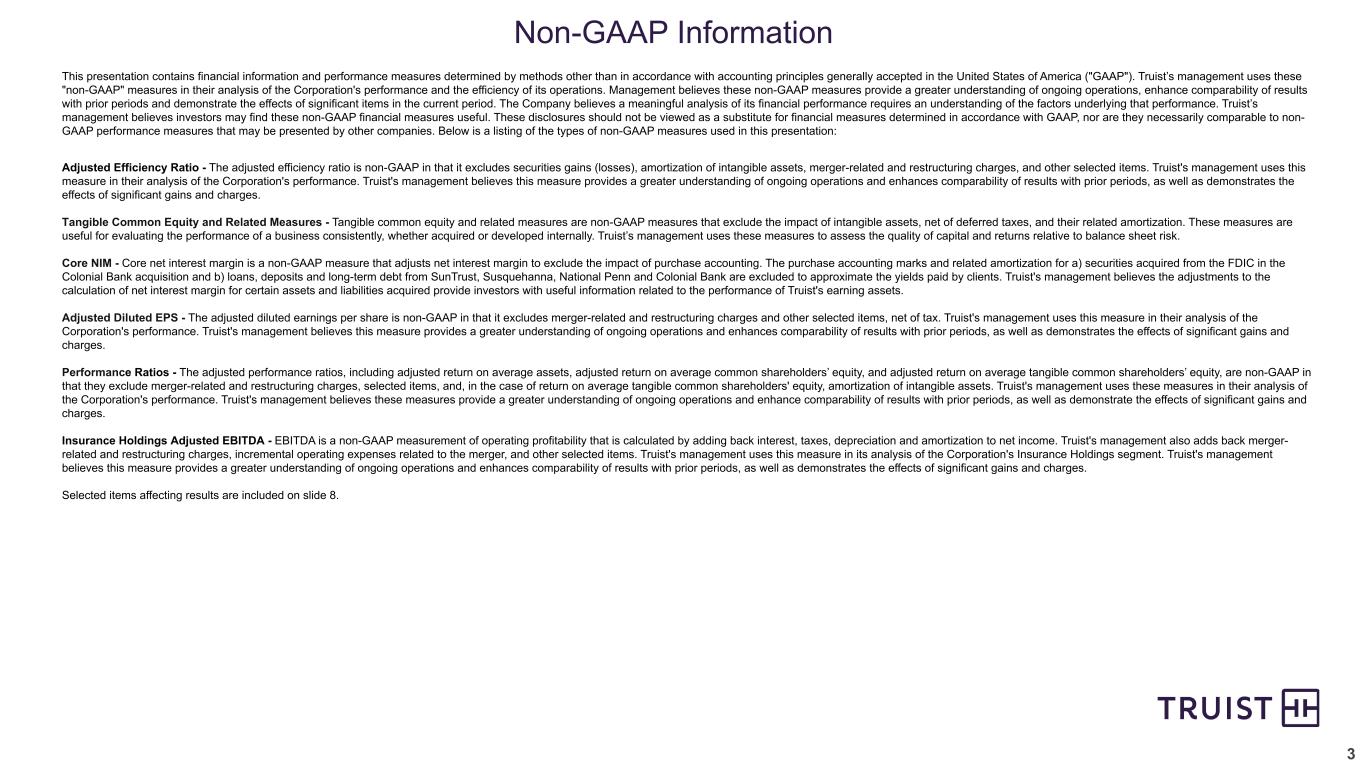
3 Non-GAAP Information This presentation contains financial information and performance measures determined by methods other than in accordance with accounting principles generally accepted in the United States of America ("GAAP"). Truist’s management uses these "non-GAAP" measures in their analysis of the Corporation's performance and the efficiency of its operations. Management believes these non-GAAP measures provide a greater understanding of ongoing operations, enhance comparability of results with prior periods and demonstrate the effects of significant items in the current period. The Company believes a meaningful analysis of its financial performance requires an understanding of the factors underlying that performance. Truist’s management believes investors may find these non-GAAP financial measures useful. These disclosures should not be viewed as a substitute for financial measures determined in accordance with GAAP, nor are they necessarily comparable to non- GAAP performance measures that may be presented by other companies. Below is a listing of the types of non-GAAP measures used in this presentation: Adjusted Efficiency Ratio - The adjusted efficiency ratio is non-GAAP in that it excludes securities gains (losses), amortization of intangible assets, merger-related and restructuring charges, and other selected items. Truist's management uses this measure in their analysis of the Corporation's performance. Truist's management believes this measure provides a greater understanding of ongoing operations and enhances comparability of results with prior periods, as well as demonstrates the effects of significant gains and charges. Tangible Common Equity and Related Measures - Tangible common equity and related measures are non-GAAP measures that exclude the impact of intangible assets, net of deferred taxes, and their related amortization. These measures are useful for evaluating the performance of a business consistently, whether acquired or developed internally. Truist’s management uses these measures to assess the quality of capital and returns relative to balance sheet risk. Core NIM - Core net interest margin is a non-GAAP measure that adjusts net interest margin to exclude the impact of purchase accounting. The purchase accounting marks and related amortization for a) securities acquired from the FDIC in the Colonial Bank acquisition and b) loans, deposits and long-term debt from SunTrust, Susquehanna, National Penn and Colonial Bank are excluded to approximate the yields paid by clients. Truist's management believes the adjustments to the calculation of net interest margin for certain assets and liabilities acquired provide investors with useful information related to the performance of Truist's earning assets. Adjusted Diluted EPS - The adjusted diluted earnings per share is non-GAAP in that it excludes merger-related and restructuring charges and other selected items, net of tax. Truist's management uses this measure in their analysis of the Corporation's performance. Truist's management believes this measure provides a greater understanding of ongoing operations and enhances comparability of results with prior periods, as well as demonstrates the effects of significant gains and charges. Performance Ratios - The adjusted performance ratios, including adjusted return on average assets, adjusted return on average common shareholders’ equity, and adjusted return on average tangible common shareholders’ equity, are non-GAAP in that they exclude merger-related and restructuring charges, selected items, and, in the case of return on average tangible common shareholders' equity, amortization of intangible assets. Truist's management uses these measures in their analysis of the Corporation's performance. Truist's management believes these measures provide a greater understanding of ongoing operations and enhance comparability of results with prior periods, as well as demonstrate the effects of significant gains and charges. Insurance Holdings Adjusted EBITDA - EBITDA is a non-GAAP measurement of operating profitability that is calculated by adding back interest, taxes, depreciation and amortization to net income. Truist's management also adds back merger- related and restructuring charges, incremental operating expenses related to the merger, and other selected items. Truist's management uses this measure in its analysis of the Corporation's Insurance Holdings segment. Truist's management believes this measure provides a greater understanding of ongoing operations and enhances comparability of results with prior periods, as well as demonstrates the effects of significant gains and charges. Selected items affecting results are included on slide 8.
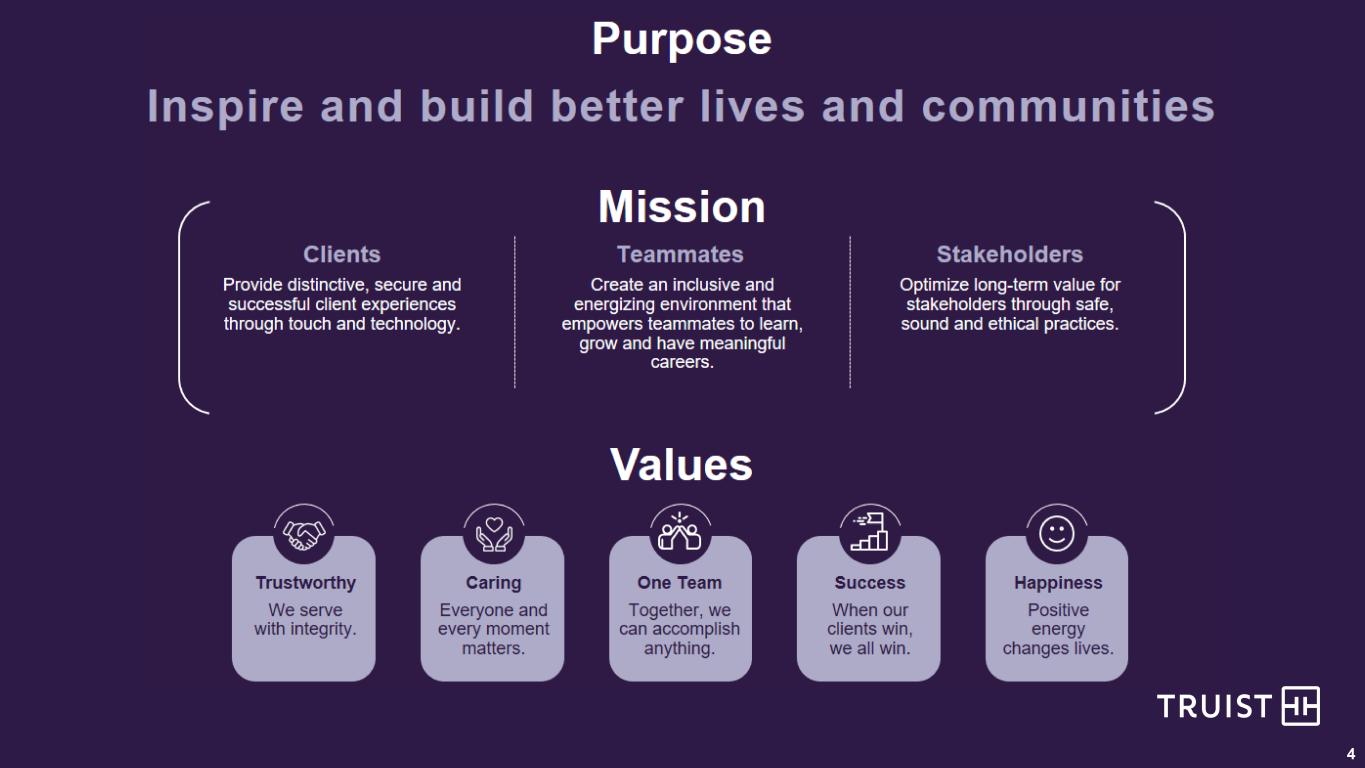
4

5 Living our purpose Inspire and build better lives and communities Community Impact, Financial Inclusion, and Education Responsible Business and Ethical Conduct Technology and Client Service Human Capital and DEI ESG, Climate Change, and Environmental Sustainability ▪ 112% of prorated goal for the $60 billion 3 year 2020-2022 Community Benefits Plan commitment1 ▪ Truist Community Capital provided over $300 million in equity in 3Q to support communities through investments in affordable housing, access to healthy foods and education, and investments in job creation and small businesses ▪ Truist and EVERFI announced all elementary students nationwide will soon have access to WORDForce Universe, a digital early literacy program ▪ 23% of small business loans under $1 million went to low- and moderate- income census tracts in 2021 ▪ BlackRock’s philanthropic Emergency Savings Initiative (ESI): As the first top 10 bank to join the ESI, Truist has attracted 25K eligible households that have opened over 30K savings accounts ▪ Migrated ~7 million clients to the new Truist digital banking experience (nearly half are beginning to use), which includes enhanced digital investment and money- management capabilities, personalized insights, and a holistic personal financial management tool ▪ Decision to stay open on Saturday of a conversion weekend (October 9, 2021) ▪ Goal to increase diversity in senior leadership roles to at least 15% by 2023; current progress: 13.7% ▪ For early career program hiring in 2021, 64% of seats at Truist were filled by diverse candidates ▪ Truist teammates have received ~$24 million through Truist Momentum—financial wellness starts at home ▪ Improvements in Truist’s ESG ratings as outlined below: • MSCI: BBB to A • ISS Quality Scores: Environment to 2, Social to 1, and Governance to 2 • R-Factor: Scored in industry top 10-30% ▪ Truist’s inaugural TCFD report launching in 4Q21 1 As of 8/31/21

3Q21 Results

7 3Q21 performance highlights Total taxable-equivalent revenue1 $5,626 $5,626 Net income available to common shareholders 1,616 1,918 1 Composed of taxable-equivalent net interest income and noninterest income 2 See non-GAAP reconciliations in the appendix 3 Current quarter regulatory capital information is preliminary Earnings and profitability ▪ Strong adjusted net income available to common shareholders of $1.9 billion (adjusted EPS: $1.42) up 46% compared to 3Q20 (primarily driven by a lower loan loss provision) • Adjusted ROTCE of 22.6% • Solid 2.3% adjusted revenue growth YoY: strong 12% adjusted fee income growth offsets 29 bps decline in NIM and 8% decline in average loans ▪ Compared to 2Q21, adjusted EPS declined 8% driven by lower provision benefit and lower adjusted PPNR • Sequentially, revenue declined 1% given lower loan balances, record fee income in prior quarter, and seasonality ▪ GAAP noninterest expense reflects $393 million of nonrecurring expenses (primarily merger related) • Sequentially, adjusted noninterest expense increased 2.4% driven by higher marketing and technology-related costs ▪ Asset quality remains excellent; NCOs were a post-financial crisis low at 19 bps Capital deployment ▪ Increased dividend 7% in 3Q21 ▪ Completed acquisition of Constellation Affiliated Partners (July 1) ▪ Announced acquisition of Service Finance (Aug 10) Merger integration ▪ Completed mortgage origination platform conversion and accelerated client migration to new Truist digital experience ▪ Part 1 of core bank conversion (heritage BBT clients to Truist ecosystem) completed this past weekend (October 9-11, 2021) and full core bank conversion on track for 1Q22 Diluted EPS $1.20 $1.42 ROA 1.28% 1.51% ROCE 10.2% 12.1% ROTCE 19.3% 22.6% Efficiency ratio 67.8% 57.9% NPAs / assets 0.23% NCOs / loans 0.19% CET1 ratio3 10.1% Key PointsSummary Income Statement ($ MM) GAAP / Unadjusted Adjusted2 Asset Quality and Capital Performance Metrics GAAP / Unadjusted Adjusted2
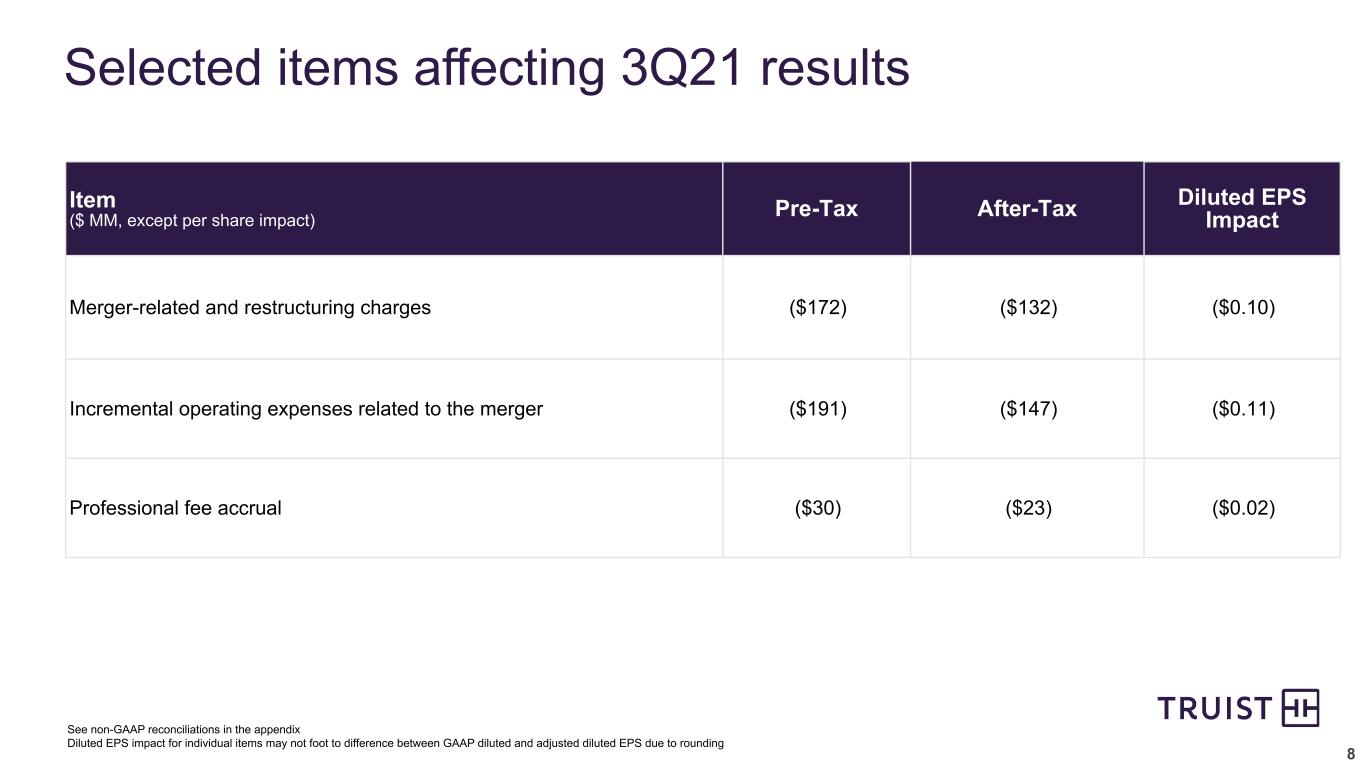
8 Selected items affecting 3Q21 results Item ($ MM, except per share impact) Pre-Tax After-Tax Diluted EPS Impact Merger-related and restructuring charges ($172) ($132) ($0.10) Incremental operating expenses related to the merger ($191) ($147) ($0.11) Professional fee accrual ($30) ($23) ($0.02) See non-GAAP reconciliations in the appendix Diluted EPS impact for individual items may not foot to difference between GAAP diluted and adjusted diluted EPS due to rounding
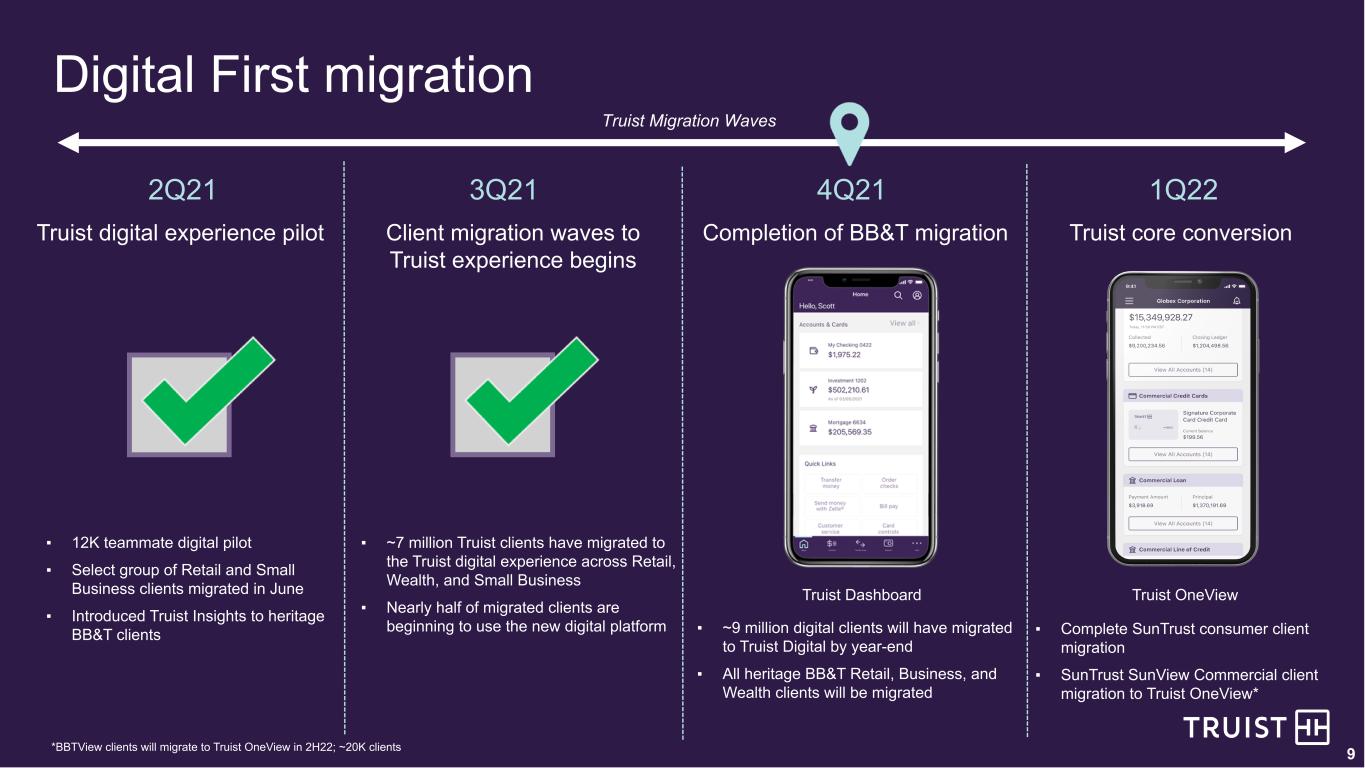
9 Digital First migration Truist Migration Waves 2Q21 3Q21 4Q21 1Q22 Truist digital experience pilot Client migration waves to Truist experience begins Completion of BB&T migration Truist core conversion ▪ 12K teammate digital pilot ▪ Select group of Retail and Small Business clients migrated in June ▪ Introduced Truist Insights to heritage BB&T clients ▪ ~7 million Truist clients have migrated to the Truist digital experience across Retail, Wealth, and Small Business ▪ Nearly half of migrated clients are beginning to use the new digital platform ▪ ~9 million digital clients will have migrated to Truist Digital by year-end ▪ All heritage BB&T Retail, Business, and Wealth clients will be migrated ▪ Complete SunTrust consumer client migration ▪ SunTrust SunView Commercial client migration to Truist OneView* Truist Dashboard Truist OneView *BBTView clients will migrate to Truist OneView in 2H22; ~20K clients
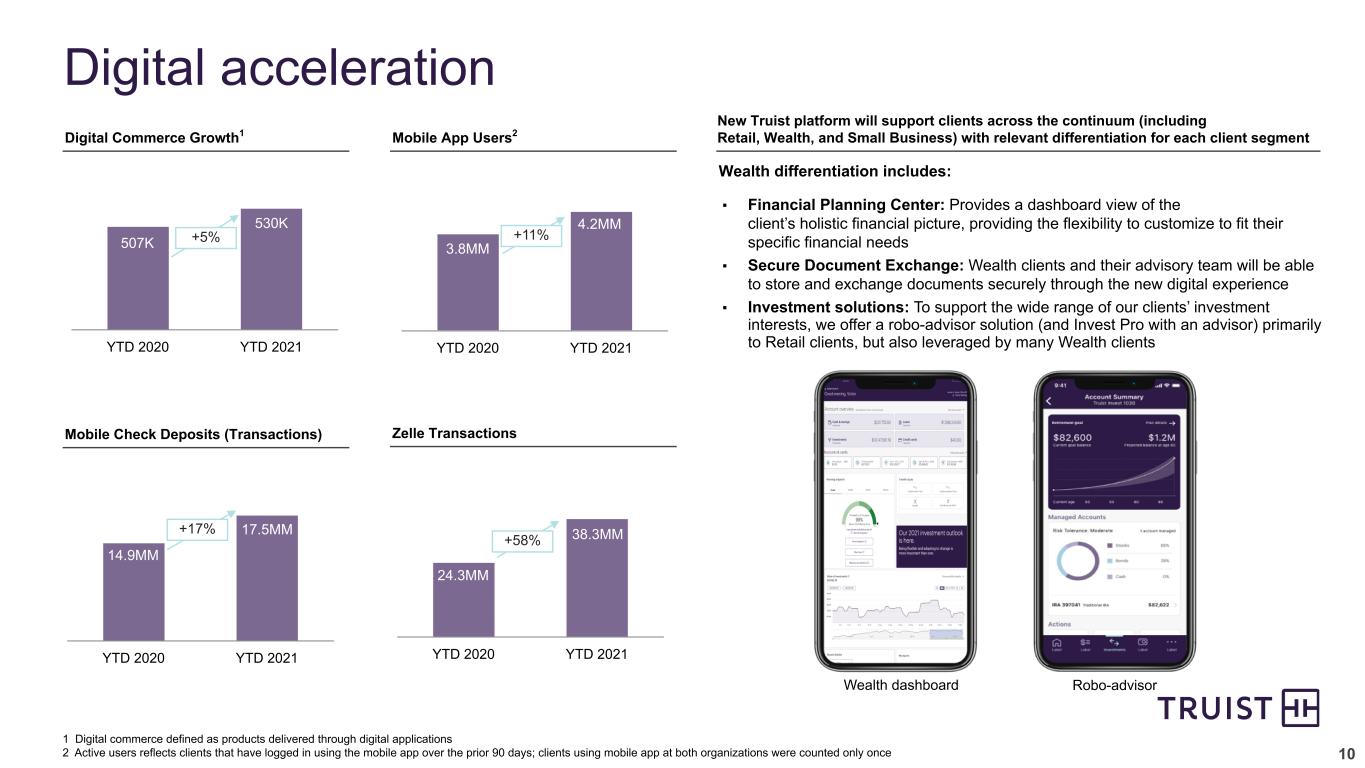
10 Digital acceleration YTD 2020 YTD 2021 YTD 2020 YTD 2021 1 Digital commerce defined as products delivered through digital applications 2 Active users reflects clients that have logged in using the mobile app over the prior 90 days; clients using mobile app at both organizations were counted only once 507K 530K 3.8MM 4.2MM Digital Commerce Growth1 Mobile App Users2 Mobile Check Deposits (Transactions) Zelle Transactions New Truist platform will support clients across the continuum (including Retail, Wealth, and Small Business) with relevant differentiation for each client segment Wealth differentiation includes: ▪ Financial Planning Center: Provides a dashboard view of the client’s holistic financial picture, providing the flexibility to customize to fit their specific financial needs ▪ Secure Document Exchange: Wealth clients and their advisory team will be able to store and exchange documents securely through the new digital experience ▪ Investment solutions: To support the wide range of our clients’ investment interests, we offer a robo-advisor solution (and Invest Pro with an advisor) primarily to Retail clients, but also leveraged by many Wealth clients +5% +11% YTD 2020 YTD 2021 14.9MM 17.5MM+17% YTD 2020 YTD 2021 24.3MM 38.3MM+58% Wealth dashboard Robo-advisor
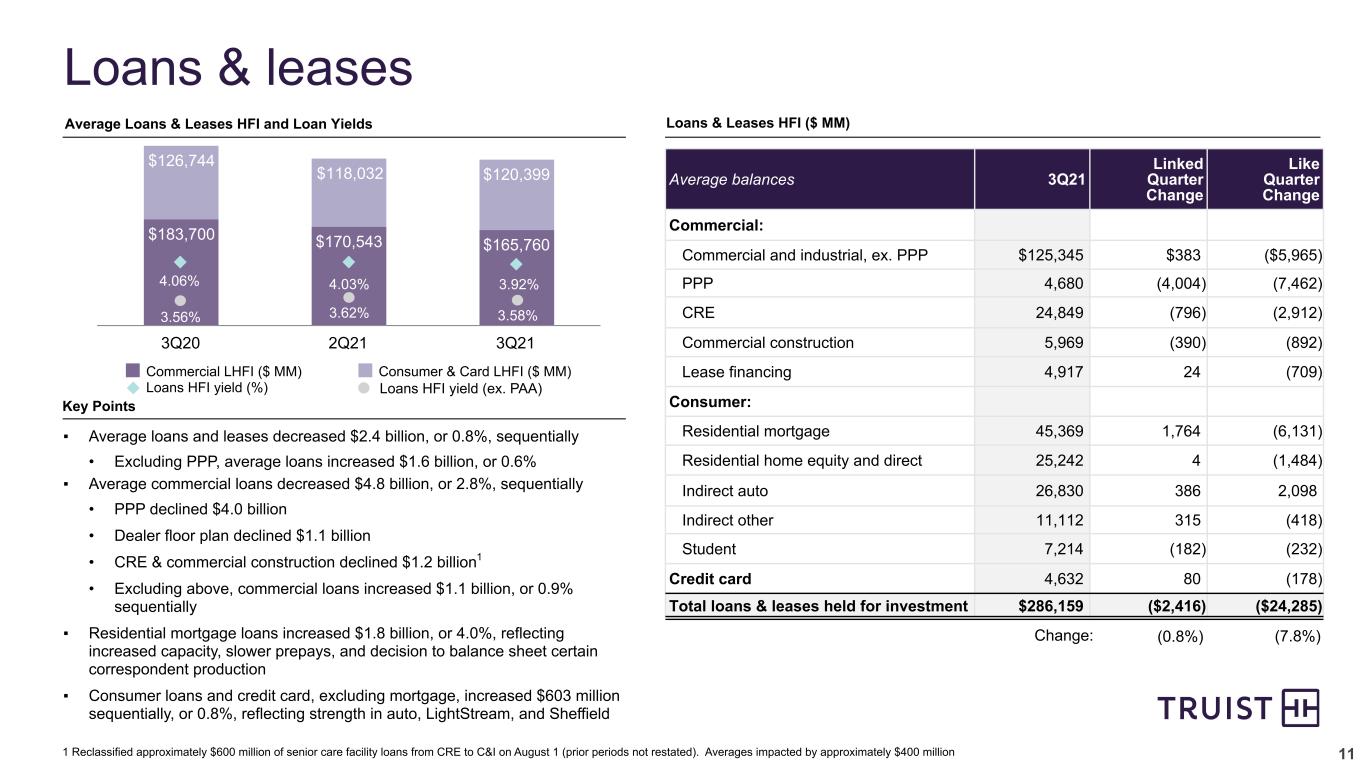
11 Loans & leases $183,700 $170,543 $165,760 $126,744 $118,032 $120,399 Commercial LHFI ($ MM) Consumer & Card LHFI ($ MM) Loans HFI yield (%) 3Q20 2Q21 3Q21 Average balances 3Q21 Linked Quarter Change Like Quarter Change Commercial: Commercial and industrial, ex. PPP $125,345 $383 ($5,965) PPP 4,680 (4,004) (7,462) CRE 24,849 (796) (2,912) Commercial construction 5,969 (390) (892) Lease financing 4,917 24 (709) Consumer: Residential mortgage 45,369 1,764 (6,131) Residential home equity and direct 25,242 4 (1,484) Indirect auto 26,830 386 2,098 Indirect other 11,112 315 (418) Student 7,214 (182) (232) Credit card 4,632 80 (178) Total loans & leases held for investment $286,159 ($2,416) ($24,285) Average Loans & Leases HFI and Loan Yields Key Points Loans & Leases HFI ($ MM) (0.8%) (7.8%)Change: ▪ Average loans and leases decreased $2.4 billion, or 0.8%, sequentially • Excluding PPP, average loans increased $1.6 billion, or 0.6% ▪ Average commercial loans decreased $4.8 billion, or 2.8%, sequentially • PPP declined $4.0 billion • Dealer floor plan declined $1.1 billion • CRE & commercial construction declined $1.2 billion1 • Excluding above, commercial loans increased $1.1 billion, or 0.9% sequentially ▪ Residential mortgage loans increased $1.8 billion, or 4.0%, reflecting increased capacity, slower prepays, and decision to balance sheet certain correspondent production ▪ Consumer loans and credit card, excluding mortgage, increased $603 million sequentially, or 0.8%, reflecting strength in auto, LightStream, and Sheffield Loans HFI yield (ex. PAA) 1 Reclassified approximately $600 million of senior care facility loans from CRE to C&I on August 1 (prior periods not restated). Averages impacted by approximately $400 million 4.06% 4.03% 3.92% 3.56% 3.62% 3.58%
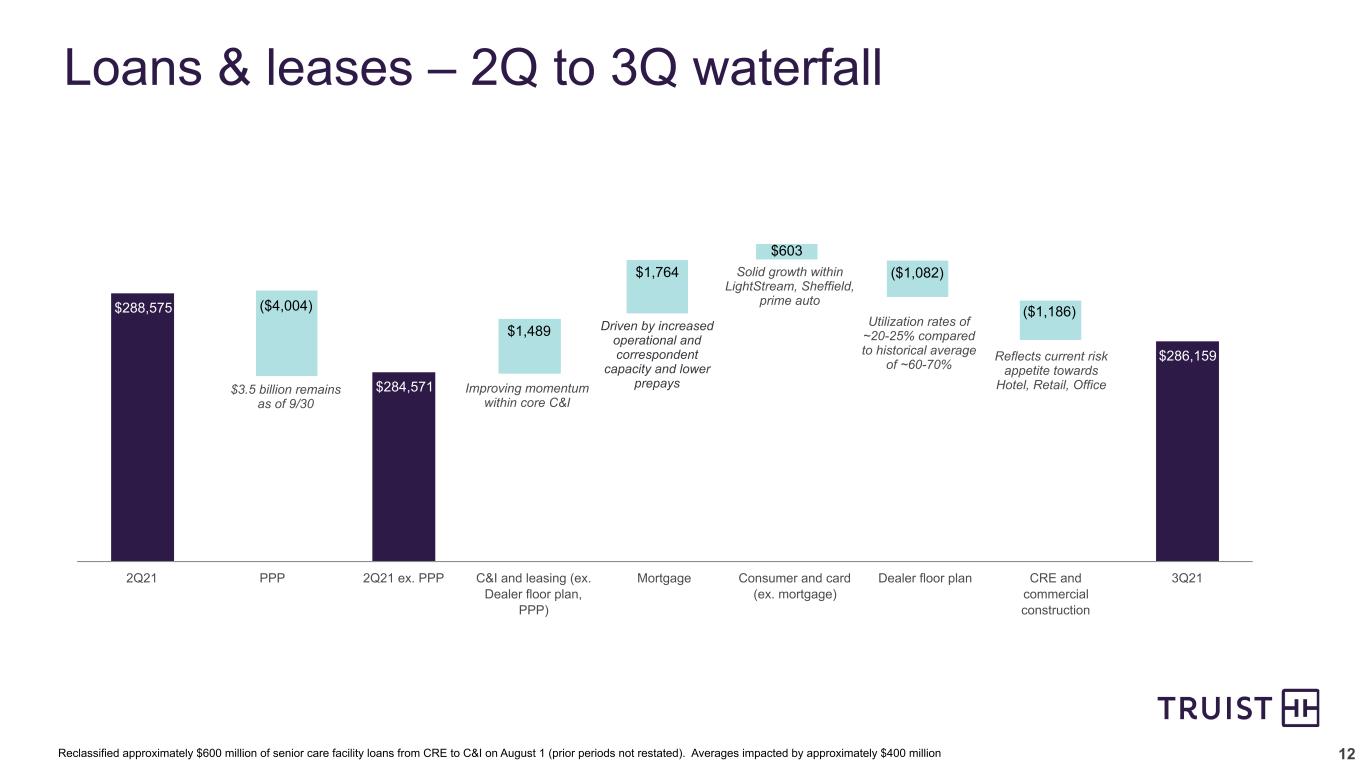
12 $288,575 $284,571 $286,159 2Q21 PPP 2Q21 ex. PPP C&I and leasing (ex. Dealer floor plan, PPP) Mortgage Consumer and card (ex. mortgage) Dealer floor plan CRE and commercial construction 3Q21 Loans & leases – 2Q to 3Q waterfall $603 $1,489 $1,764 ($4,004) ($1,082) ($1,186) Improving momentum within core C&I Driven by increased operational and correspondent capacity and lower prepays Solid growth within LightStream, Sheffield, prime auto $3.5 billion remains as of 9/30 Utilization rates of ~20-25% compared to historical average of ~60-70% Reflects current risk appetite towards Hotel, Retail, Office Reclassified approximately $600 million of senior care facility loans from CRE to C&I on August 1 (prior periods not restated). Averages impacted by approximately $400 million

13 Deposits $372,211 $396,255 $402,728 0.10% 0.04% 0.03% Total deposits ($ MM) Total deposit cost (%) 3Q20 2Q21 3Q21 ▪ Average deposits grew $6.5 billion, or 1.6%; reflects ongoing government stimulus ▪ Noninterest-bearing deposits were 35% of total deposits in 3Q21 ▪ Total deposit cost declined 1 bp to 3 bps, sequentially ▪ Loan-to-deposit ratio was 71% (based on average balances) ▪ Building franchise value • Net client attrition of closed branches <1% • Net new personal DDA of ~50K YTD (7x YoY) • Net new business DDA of ~45K YTD (+11% YoY) Average balances 3Q21 Linked Quarter Change Like Quarter Change Noninterest-bearing deposits $141,738 $3,846 $17,772 Interest checking 107,802 1,681 11,095 Money market and savings 136,094 2,065 12,496 Time deposits 17,094 (1,119) (10,846) Total deposits $402,728 $6,473 $30,517 Key Points Average Deposits & Costs Deposits ($ MM) Change: +1.6% +8.2%
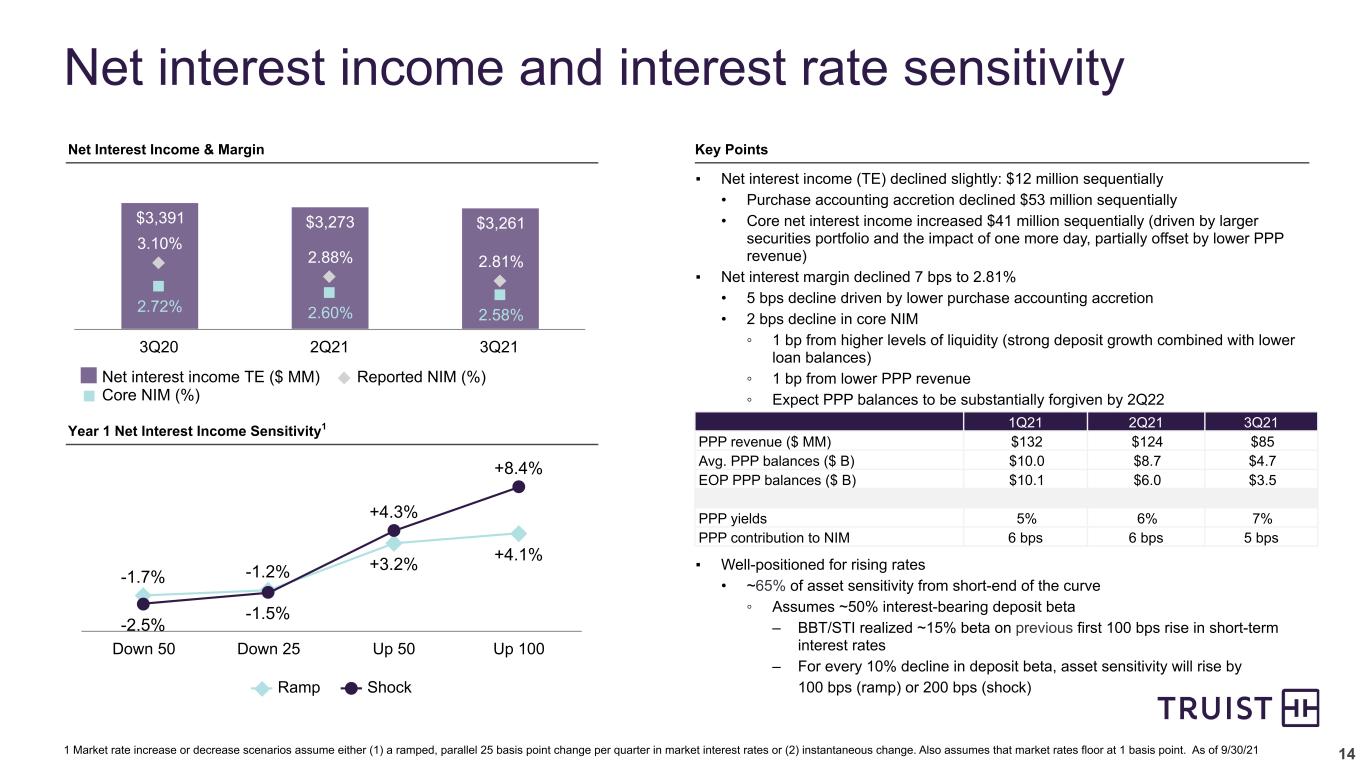
14 Net interest income and interest rate sensitivity ▪ Net interest income (TE) declined slightly: $12 million sequentially • Purchase accounting accretion declined $53 million sequentially • Core net interest income increased $41 million sequentially (driven by larger securities portfolio and the impact of one more day, partially offset by lower PPP revenue) ▪ Net interest margin declined 7 bps to 2.81% • 5 bps decline driven by lower purchase accounting accretion • 2 bps decline in core NIM ◦ 1 bp from higher levels of liquidity (strong deposit growth combined with lower loan balances) ◦ 1 bp from lower PPP revenue ◦ Expect PPP balances to be substantially forgiven by 2Q22 ▪ Well-positioned for rising rates • ~65% of asset sensitivity from short-end of the curve ◦ Assumes ~50% interest-bearing deposit beta – BBT/STI realized ~15% beta on previous first 100 bps rise in short-term interest rates – For every 10% decline in deposit beta, asset sensitivity will rise by 100 bps (ramp) or 200 bps (shock) $3,391 $3,273 $3,261 3.10% 2.88% 2.81% 2.72% 2.60% 2.58% Net interest income TE ($ MM) Reported NIM (%) Core NIM (%) 3Q20 2Q21 3Q21 -1.7% -1.2% +3.2% +4.1% -2.5% -1.5% +4.3% +8.4% Ramp Shock Down 50 Down 25 Up 50 Up 100 1 Market rate increase or decrease scenarios assume either (1) a ramped, parallel 25 basis point change per quarter in market interest rates or (2) instantaneous change. Also assumes that market rates floor at 1 basis point. As of 9/30/21 Key PointsNet Interest Income & Margin Year 1 Net Interest Income Sensitivity1 1Q21 2Q21 3Q21 PPP revenue ($ MM) $132 $124 $85 Avg. PPP balances ($ B) $10.0 $8.7 $4.7 EOP PPP balances ($ B) $10.1 $6.0 $3.5 PPP yields 5% 6% 7% PPP contribution to NIM 6 bps 6 bps 5 bps
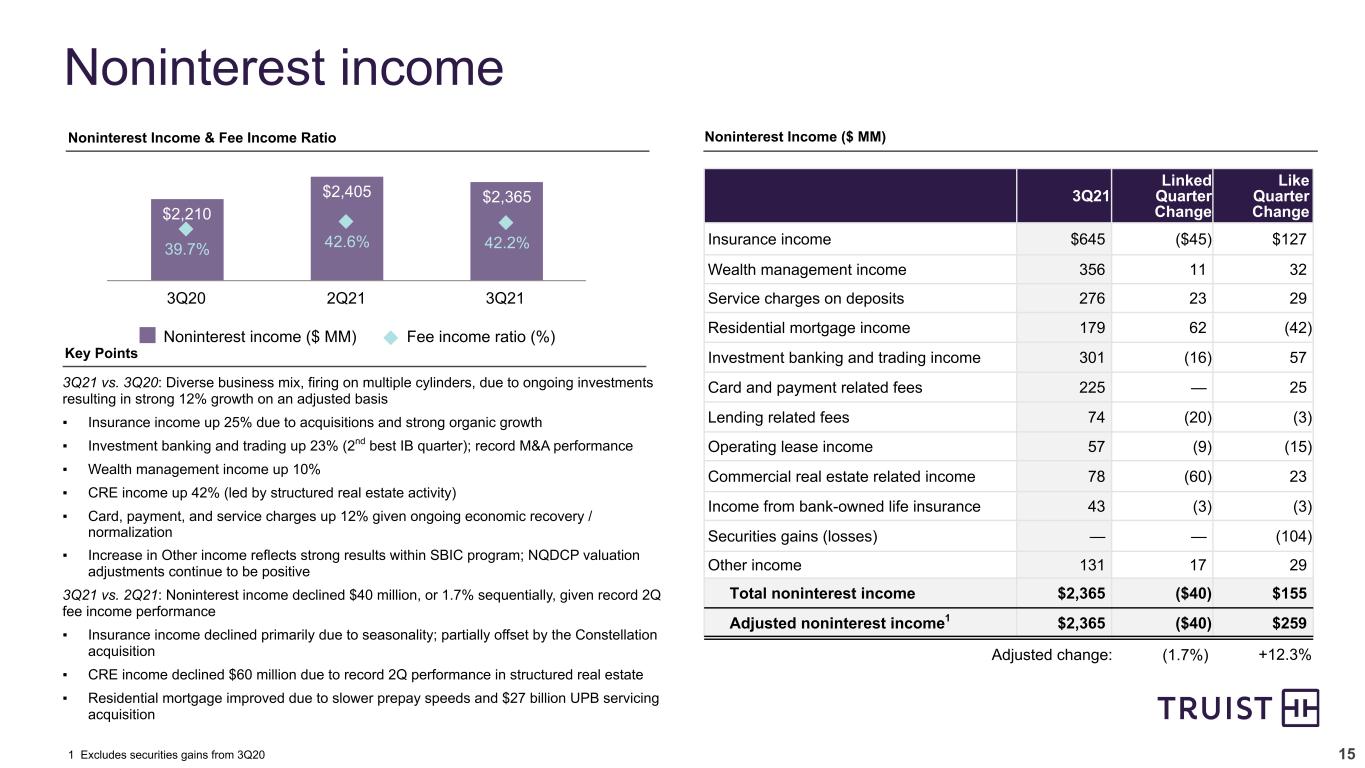
15 Noninterest income 3Q21 Linked Quarter Change Like Quarter Change Insurance income $645 ($45) $127 Wealth management income 356 11 32 Service charges on deposits 276 23 29 Residential mortgage income 179 62 (42) Investment banking and trading income 301 (16) 57 Card and payment related fees 225 — 25 Lending related fees 74 (20) (3) Operating lease income 57 (9) (15) Commercial real estate related income 78 (60) 23 Income from bank-owned life insurance 43 (3) (3) Securities gains (losses) — — (104) Other income 131 17 29 Total noninterest income $2,365 ($40) $155 Adjusted noninterest income1 $2,365 ($40) $259 $2,210 $2,405 $2,365 39.7% 42.6% 42.2% Noninterest income ($ MM) Fee income ratio (%) 3Q20 2Q21 3Q21 1 Excludes securities gains from 3Q20 Noninterest Income & Fee Income Ratio Noninterest Income ($ MM) 3Q21 vs. 3Q20: Diverse business mix, firing on multiple cylinders, due to ongoing investments resulting in strong 12% growth on an adjusted basis ▪ Insurance income up 25% due to acquisitions and strong organic growth ▪ Investment banking and trading up 23% (2nd best IB quarter); record M&A performance ▪ Wealth management income up 10% ▪ CRE income up 42% (led by structured real estate activity) ▪ Card, payment, and service charges up 12% given ongoing economic recovery / normalization ▪ Increase in Other income reflects strong results within SBIC program; NQDCP valuation adjustments continue to be positive 3Q21 vs. 2Q21: Noninterest income declined $40 million, or 1.7% sequentially, given record 2Q fee income performance ▪ Insurance income declined primarily due to seasonality; partially offset by the Constellation acquisition ▪ CRE income declined $60 million due to record 2Q performance in structured real estate ▪ Residential mortgage improved due to slower prepay speeds and $27 billion UPB servicing acquisition Key Points Adjusted change: (1.7%) +12.3%
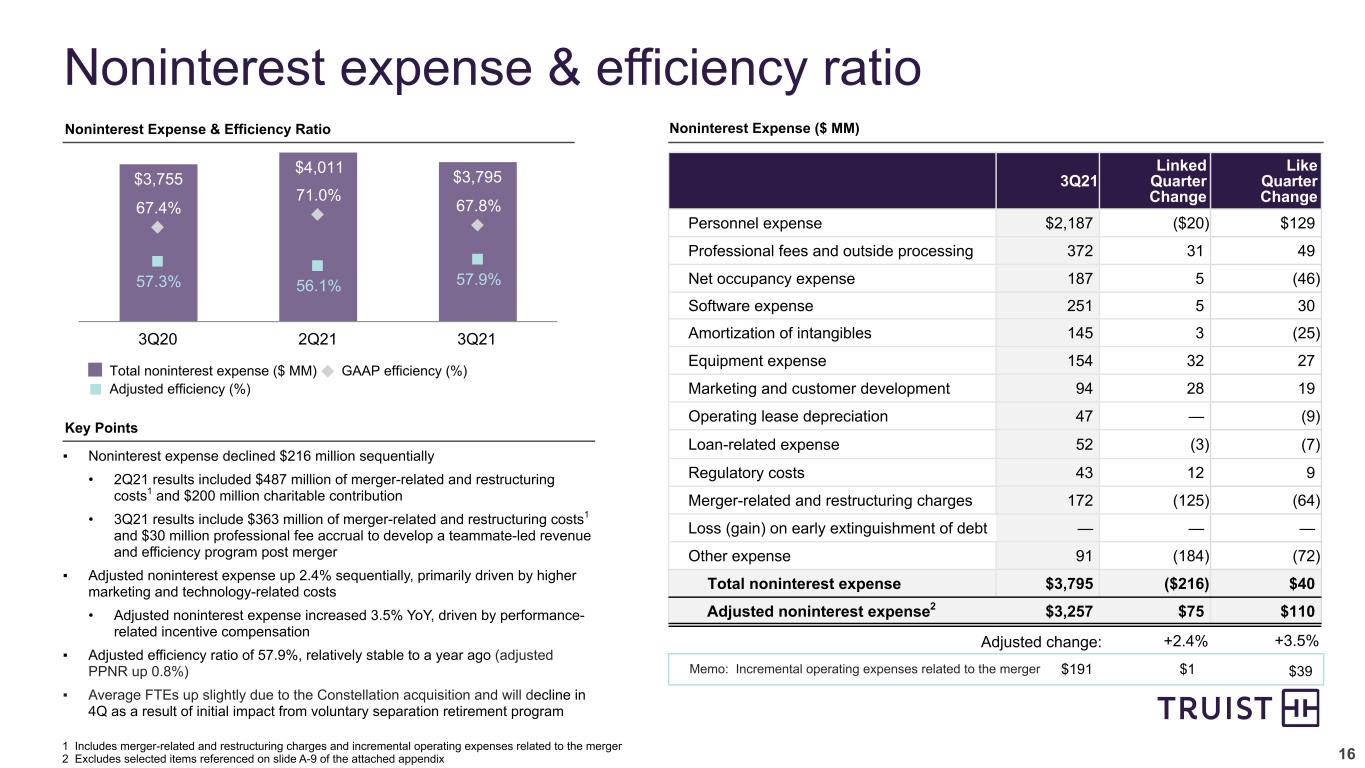
16 Noninterest expense & efficiency ratio ▪ Noninterest expense declined $216 million sequentially • 2Q21 results included $487 million of merger-related and restructuring costs1 and $200 million charitable contribution • 3Q21 results include $363 million of merger-related and restructuring costs1 and $30 million professional fee accrual to develop a teammate-led revenue and efficiency program post merger ▪ Adjusted noninterest expense up 2.4% sequentially, primarily driven by higher marketing and technology-related costs • Adjusted noninterest expense increased 3.5% YoY, driven by performance- related incentive compensation ▪ Adjusted efficiency ratio of 57.9%, relatively stable to a year ago (adjusted PPNR up 0.8%) ▪ Average FTEs up slightly due to the Constellation acquisition and will decline in 4Q as a result of initial impact from voluntary separation retirement program 3Q21 Linked Quarter Change Like Quarter Change Personnel expense $2,187 ($20) $129 Professional fees and outside processing 372 31 49 Net occupancy expense 187 5 (46) Software expense 251 5 30 Amortization of intangibles 145 3 (25) Equipment expense 154 32 27 Marketing and customer development 94 28 19 Operating lease depreciation 47 — (9) Loan-related expense 52 (3) (7) Regulatory costs 43 12 9 Merger-related and restructuring charges 172 (125) (64) Loss (gain) on early extinguishment of debt — — — Other expense 91 (184) (72) Total noninterest expense $3,795 ($216) $40 Adjusted noninterest expense2 $3,257 $75 $110 $3,755 $4,011 $3,795 67.4% 71.0% 67.8% 57.3% 56.1% 57.9% Total noninterest expense ($ MM) GAAP efficiency (%) Adjusted efficiency (%) 3Q20 2Q21 3Q21 1 Includes merger-related and restructuring charges and incremental operating expenses related to the merger 2 Excludes selected items referenced on slide A-9 of the attached appendix Noninterest Expense & Efficiency Ratio Noninterest Expense ($ MM) Key Points Memo: Incremental operating expenses related to the merger Adjusted change: +2.4% +3.5% $191 $1 $39
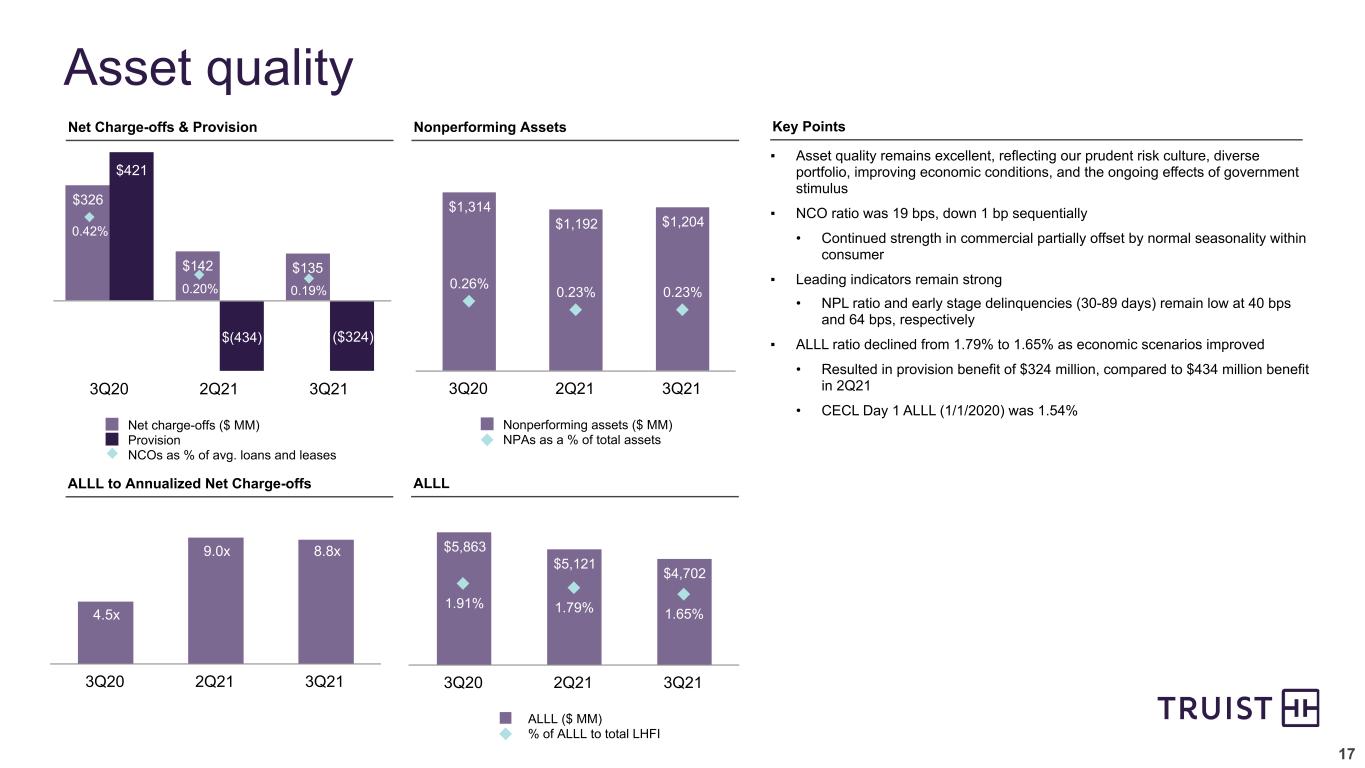
17 Asset quality $1,314 $1,192 $1,204 0.26% 0.23% 0.23% Nonperforming assets ($ MM) NPAs as a % of total assets 3Q20 2Q21 3Q21 $326 $142 $135 $(434) Net charge-offs ($ MM) Provision NCOs as % of avg. loans and leases 3Q20 2Q21 3Q21 0.42% 3Q20 2Q21 3Q21 4.5x 9.0x 0.20% ▪ Asset quality remains excellent, reflecting our prudent risk culture, diverse portfolio, improving economic conditions, and the ongoing effects of government stimulus ▪ NCO ratio was 19 bps, down 1 bp sequentially • Continued strength in commercial partially offset by normal seasonality within consumer ▪ Leading indicators remain strong • NPL ratio and early stage delinquencies (30-89 days) remain low at 40 bps and 64 bps, respectively ▪ ALLL ratio declined from 1.79% to 1.65% as economic scenarios improved • Resulted in provision benefit of $324 million, compared to $434 million benefit in 2Q21 • CECL Day 1 ALLL (1/1/2020) was 1.54% Key PointsNet Charge-offs & Provision Nonperforming Assets ALLL to Annualized Net Charge-offs $5,863 $5,121 $4,702 1.91% 1.79% 1.65% ALLL ($ MM) % of ALLL to total LHFI 3Q20 2Q21 3Q21 ALLL 8.8x 0.19% $421 ($324)

18 Capital and liquidity position Capital position ▪ CET1 ratio was 10.1% ▪ Dividend of $0.48 per share (7% increase compared to previous level) • Reflects 40% payout ratio on GAAP EPS and 34% payout ratio on adjusted EPS ▪ No share repurchases in 3Q21 given acquisition activity; share repurchases likely to resume in 4Q21 ▪ Capital deployment activity • ~$900 million capital consumed for Constellation acquisition (July 1) • $2.0 billion cash acquisition of Service Finance (expect close by year-end) ◦ ~$1.8 billion capital consumption given existing TBV • ~$1-2 billion of potential incremental capital deployment capacity (acquisitions and/or share repurchases) over next 4 quarters (4Q21 to 3Q22) Liquidity remains strong ▪ Average LCR for 3Q21 was 114% ▪ Liquid asset buffer was 24.5% ▪ Loan-to-deposit ratio of 71% 10.0% 10.2% 10.1% Common Equity Tier 1 Tier 1 Total 3Q20 2Q21 3Q21 Current quarter regulatory capital information is preliminary Liquid asset buffer is defined as cash + unencumbered securities divided by total assets 12.2% 14.6% 12.0% 117% 113% 114% $79.9 $83.5 $85.8 LCR HQLA ($ B) 3Q20 2Q21 3Q21 14.2% Key PointsCapital Ratios Category III LCR & HQLA 13.9% 11.9%
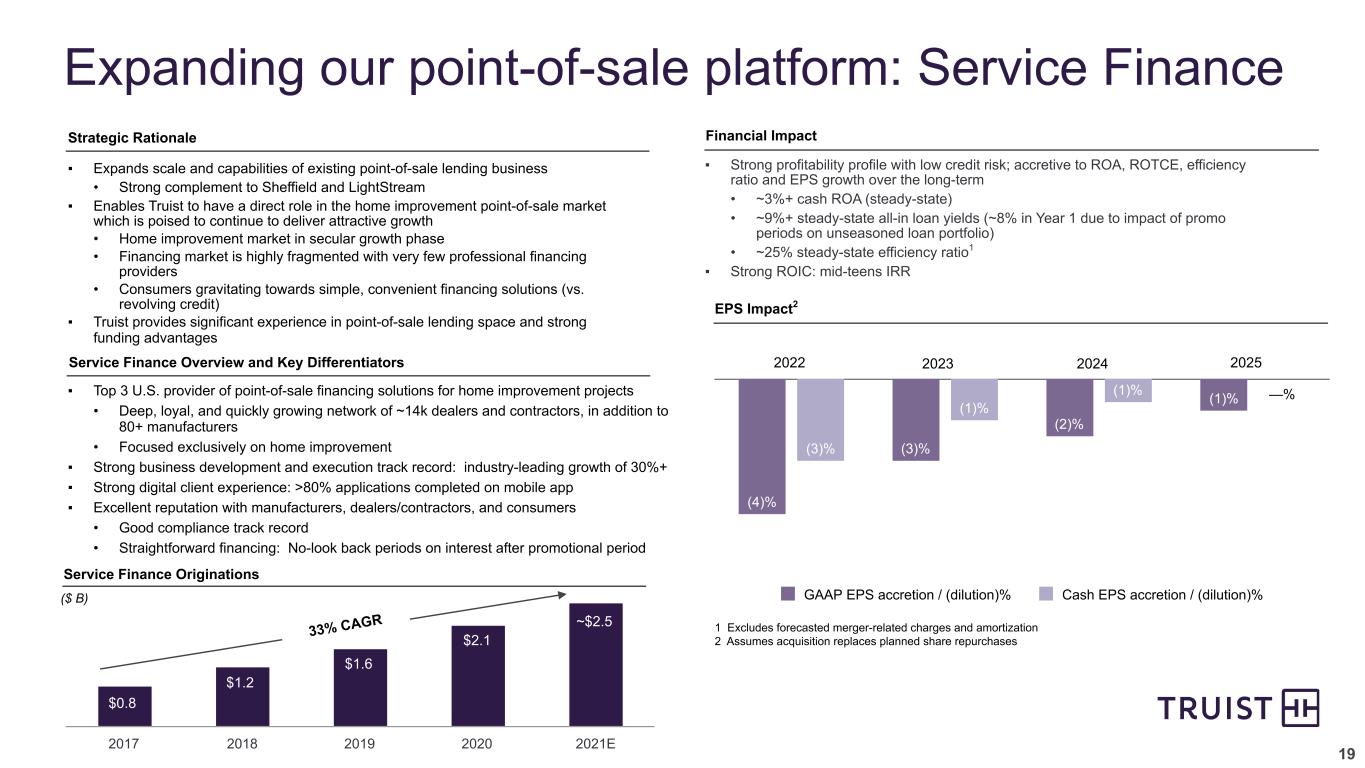
192017 2018 2019 2020 2021E ($ B) Expanding our point-of-sale platform: Service Finance Strategic Rationale ▪ Expands scale and capabilities of existing point-of-sale lending business • Strong complement to Sheffield and LightStream ▪ Enables Truist to have a direct role in the home improvement point-of-sale market which is poised to continue to deliver attractive growth • Home improvement market in secular growth phase • Financing market is highly fragmented with very few professional financing providers • Consumers gravitating towards simple, convenient financing solutions (vs. revolving credit) ▪ Truist provides significant experience in point-of-sale lending space and strong funding advantages Service Finance Originations ~$2.5 Financial Impact 1 Excludes forecasted merger-related charges and amortization 2 Assumes acquisition replaces planned share repurchases Service Finance Overview and Key Differentiators ▪ Top 3 U.S. provider of point-of-sale financing solutions for home improvement projects • Deep, loyal, and quickly growing network of ~14k dealers and contractors, in addition to 80+ manufacturers • Focused exclusively on home improvement ▪ Strong business development and execution track record: industry-leading growth of 30%+ ▪ Strong digital client experience: >80% applications completed on mobile app ▪ Excellent reputation with manufacturers, dealers/contractors, and consumers • Good compliance track record • Straightforward financing: No-look back periods on interest after promotional period 33% CAGR ▪ Strong profitability profile with low credit risk; accretive to ROA, ROTCE, efficiency ratio and EPS growth over the long-term • ~3%+ cash ROA (steady-state) • ~9%+ steady-state all-in loan yields (~8% in Year 1 due to impact of promo periods on unseasoned loan portfolio) • ~25% steady-state efficiency ratio1 ▪ Strong ROIC: mid-teens IRR EPS Impact2 (4)% (3)% (2)% (1)% (3)% (1)% (1)% —% GAAP EPS accretion / (dilution)% Cash EPS accretion / (dilution)% $2.1 $1.6 $1.2 $0.8 2022 2023 2024 2025

Merger Integration Update
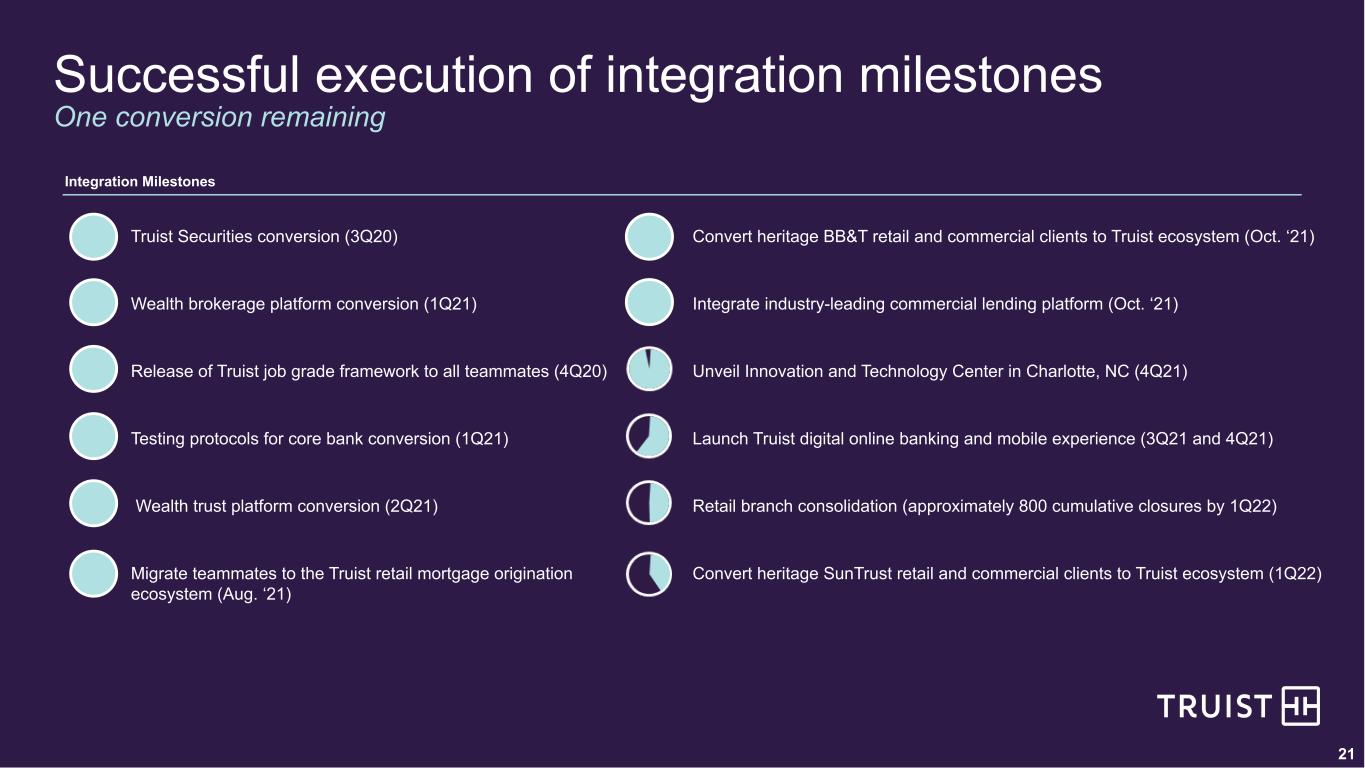
21 Successful execution of integration milestones Truist Securities conversion (3Q20) Wealth brokerage platform conversion (1Q21) Release of Truist job grade framework to all teammates (4Q20) Testing protocols for core bank conversion (1Q21) Wealth trust platform conversion (2Q21) Migrate teammates to the Truist retail mortgage origination ecosystem (Aug. ‘21) Integration Milestones Convert heritage BB&T retail and commercial clients to Truist ecosystem (Oct. ‘21) Integrate industry-leading commercial lending platform (Oct. ‘21) Unveil Innovation and Technology Center in Charlotte, NC (4Q21) Launch Truist digital online banking and mobile experience (3Q21 and 4Q21) Retail branch consolidation (approximately 800 cumulative closures by 1Q22) Convert heritage SunTrust retail and commercial clients to Truist ecosystem (1Q22) One conversion remaining
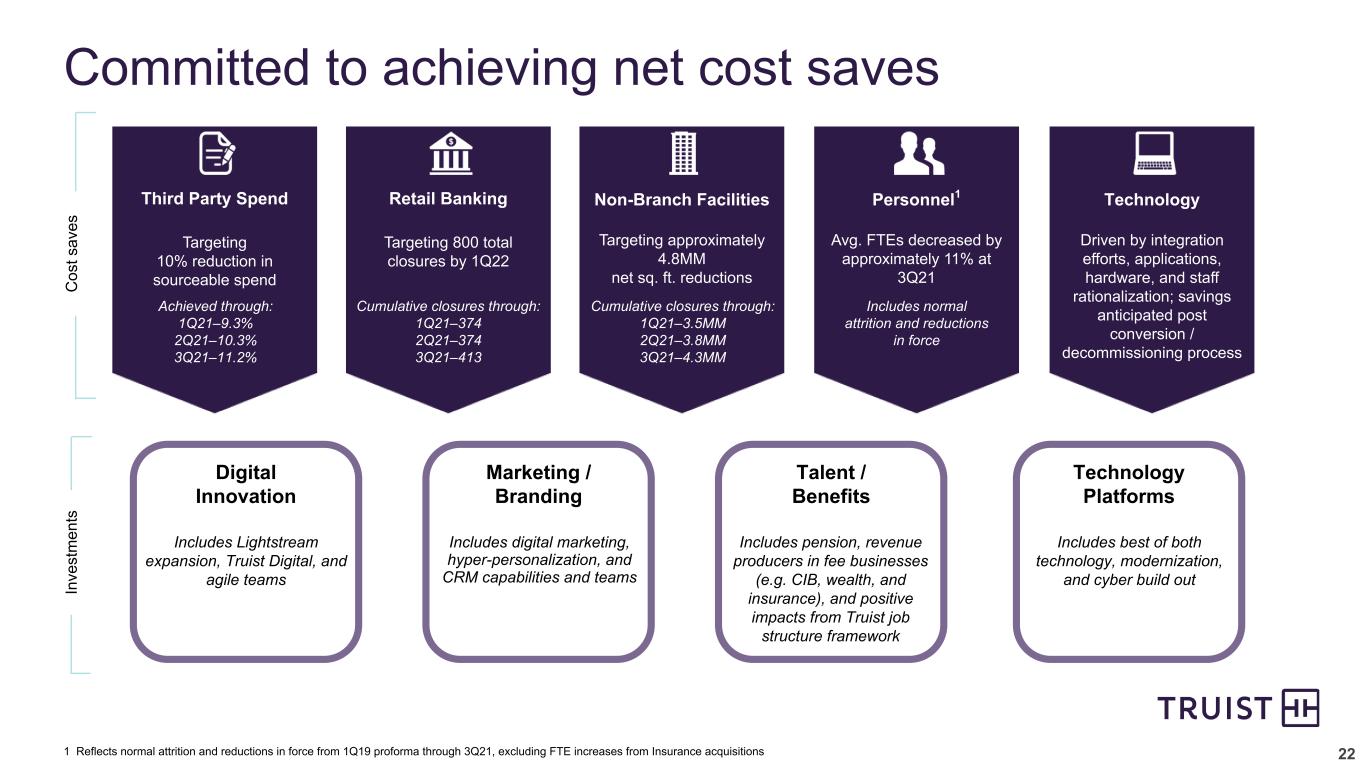
22 Committed to achieving net cost saves Digital Innovation Marketing / Branding Talent / Benefits Technology Platforms Third Party Spend Targeting 10% reduction in sourceable spend Non-Branch Facilities Targeting approximately 4.8MM net sq. ft. reductions Retail Banking Targeting 800 total closures by 1Q22 Technology Driven by integration efforts, applications, hardware, and staff rationalization; savings anticipated post conversion / decommissioning process Personnel1 Avg. FTEs decreased by approximately 11% at 3Q21 1 Reflects normal attrition and reductions in force from 1Q19 proforma through 3Q21, excluding FTE increases from Insurance acquisitions Achieved through: 1Q21–9.3% 2Q21–10.3% 3Q21–11.2% Cumulative closures through: 1Q21–374 2Q21–374 3Q21–413 Cumulative closures through: 1Q21–3.5MM 2Q21–3.8MM 3Q21–4.3MM C os t s av es In ve st m en ts Includes normal attrition and reductions in force Includes Lightstream expansion, Truist Digital, and agile teams Includes digital marketing, hyper-personalization, and CRM capabilities and teams Includes pension, revenue producers in fee businesses (e.g. CIB, wealth, and insurance), and positive impacts from Truist job structure framework Includes best of both technology, modernization, and cyber build out

23 Merger cost update Anticipated total merger costs through 2022 (not in run rate thereafter) Estimated total merger-related and restructuring charges and incremental operating expenses include costs projected through 2022 (not expected be part of the run rate post 2022); Only includes merger and restructuring charges associated with the BB&T and SunTrust MOE (i.e. excludes merger costs associated with insurance acquisitions) ▪ Expenses to complete merger with no future benefit include: • Severance and compensation ◦ (E.g. primarily severance payments) • Occupancy and equipment ◦ (E.g. impairments related to vacated buildings) • Professional fees and outside processing ◦ (E.g. investment banker and legal fees related to the merger as well as 3rd party labor related to system conversions and decommissioning) • System conversion costs ◦ (E.g. write-offs for technology assets) ExamplesEst. Total Merger Related and Restructuring Charges Est. Total Incremental Operating Expense Related to the Merger $1.8B $2.1B incurred Feb.’19–Sept. ‘21 $1.3B $1.8B ▪ Expenses for which the ongoing entity receives a future benefit include: • Personnel ◦ (E.g. salaries and incentive expense for FTEs dedicated to merger integration work) • Professional fees and outside processing ◦ (E.g. 3rd party labor related to target future state system design, optimization, and enhancement) • Marketing and other developments ◦ (E.g. rebranding costs) • All other operating expenses ◦ (E.g. includes net occupancy, software, equipment, loan processing, and other expense) Examples incurred Feb.’19–Sept. ‘21 A pproxim ately $1 billion rem aining
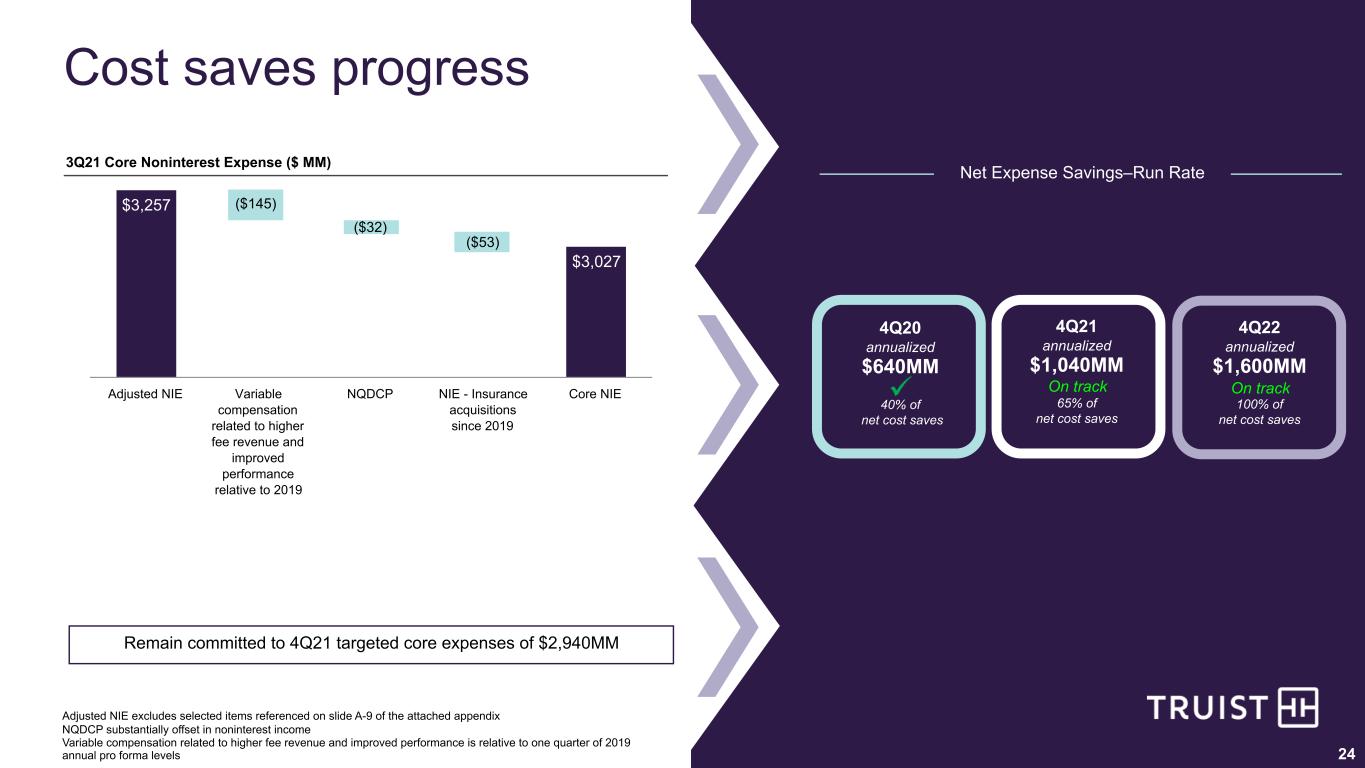
24 Cost saves progress 4Q20 annualized $640MM 40% of net cost saves 4Q21 annualized $1,040MM 65% of net cost saves 4Q22 annualized $1,600MM 100% of net cost saves $3,257 $3,027 Adjusted NIE Variable compensation related to higher fee revenue and improved performance relative to 2019 NQDCP NIE - Insurance acquisitions since 2019 Core NIE Adjusted NIE excludes selected items referenced on slide A-9 of the attached appendix NQDCP substantially offset in noninterest income Variable compensation related to higher fee revenue and improved performance is relative to one quarter of 2019 annual pro forma levels 3Q21 Core Noninterest Expense ($ MM) Remain committed to 4Q21 targeted core expenses of $2,940MM On track On track Net Expense Savings–Run Rate ($145) ($32) ($53)
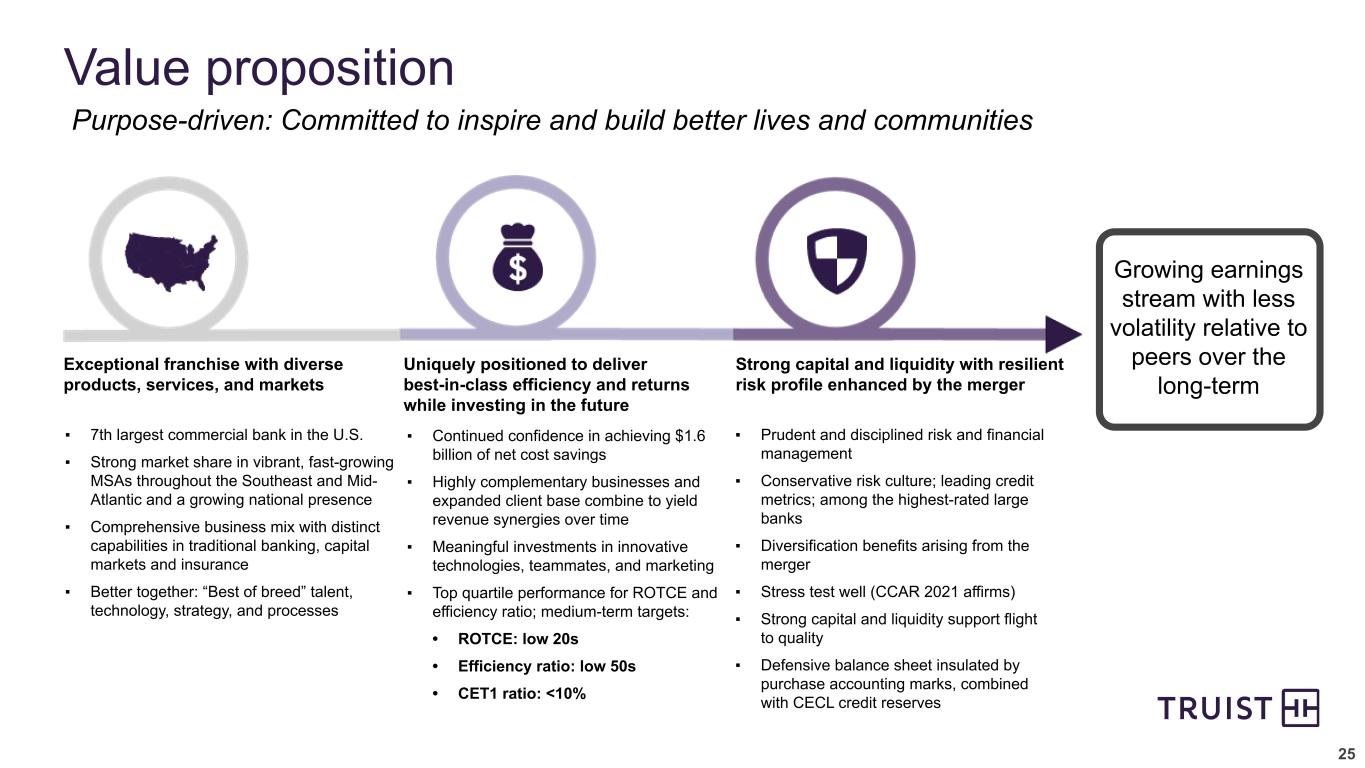
25 Value proposition Purpose-driven: Committed to inspire and build better lives and communities Growing earnings stream with less volatility relative to peers over the long-term ▪ 7th largest commercial bank in the U.S. ▪ Strong market share in vibrant, fast-growing MSAs throughout the Southeast and Mid- Atlantic and a growing national presence ▪ Comprehensive business mix with distinct capabilities in traditional banking, capital markets and insurance ▪ Better together: “Best of breed” talent, technology, strategy, and processes ▪ Continued confidence in achieving $1.6 billion of net cost savings ▪ Highly complementary businesses and expanded client base combine to yield revenue synergies over time ▪ Meaningful investments in innovative technologies, teammates, and marketing ▪ Top quartile performance for ROTCE and efficiency ratio; medium-term targets: • ROTCE: low 20s • Efficiency ratio: low 50s • CET1 ratio: <10% ▪ Prudent and disciplined risk and financial management ▪ Conservative risk culture; leading credit metrics; among the highest-rated large banks ▪ Diversification benefits arising from the merger ▪ Stress test well (CCAR 2021 affirms) ▪ Strong capital and liquidity support flight to quality ▪ Defensive balance sheet insulated by purchase accounting marks, combined with CECL credit reserves Exceptional franchise with diverse products, services, and markets Uniquely positioned to deliver best-in-class efficiency and returns while investing in the future Strong capital and liquidity with resilient risk profile enhanced by the merger

26 3Q21 results in the context of our value proposition Total Assets $1,086 $1,302 3Q20 3Q21 Fee Income Diversity Exceptional Franchise1 Uniquely Positioned2 $0.97 $1.42 3Q20 3Q21 Adjusted Diluted EPS 46% 16.1% 22.6% 3Q20 3Q21 Adjusted ROTCE 40% Strong Capital, Liquidity, & Risk Mgmt.3 57% 40% 3Q20 3Q21 Total Payout Ratio 0.42% 0.19% 3Q20 3Q21 NCOs / Loans 55% $499 $530 3Q20 3Q21 1 Source: S&P Global as of 9/8/21; demographic data as of 1/1/21; deposit data as of 6/30/21, pro forma for completed and announced M&A through 9/8/21. ’21-’26E projected growth deposit weighted by county. 2 Impact of Constellation acquisition $ in billions, except per share impact Insurance, Investment Banking, & Wealth Current CET1 ratio = 10.1%; near-term target = 9.75% 7th largest US commercial bank; highest proj. pop. growth compared to peers1 6.2% 20% 67% 55%2

Appendix
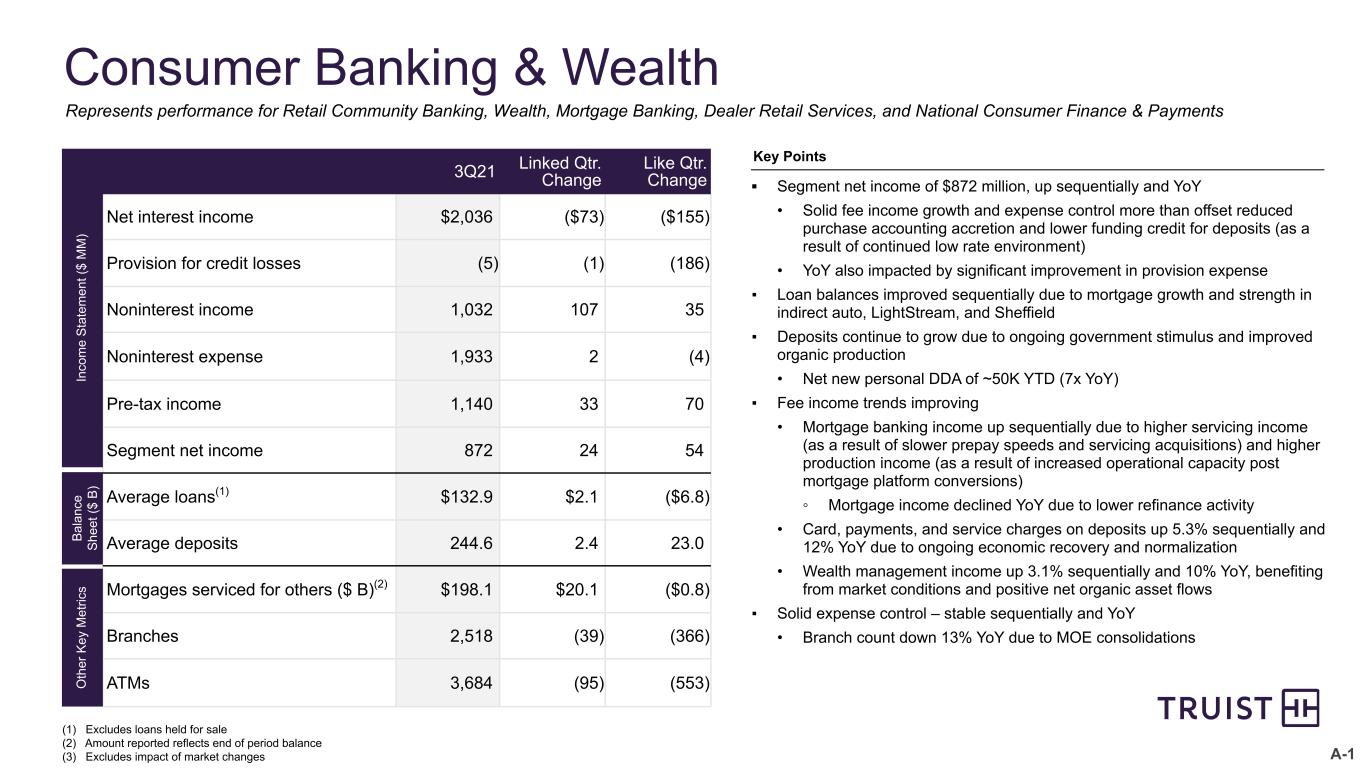
A-1 Consumer Banking & Wealth 3Q21 Linked Qtr. Change Like Qtr. Change Net interest income $2,036 ($73) ($155) Provision for credit losses (5) (1) (186) Noninterest income 1,032 107 35 Noninterest expense 1,933 2 (4) Pre-tax income 1,140 33 70 Segment net income 872 24 54 Average loans(1) $132.9 $2.1 ($6.8) Average deposits 244.6 2.4 23.0 Mortgages serviced for others ($ B)(2) $198.1 $20.1 ($0.8) Branches 2,518 (39) (366) ATMs 3,684 (95) (553) In co m e S ta te m en t ( $ M M ) B al an ce S he et ($ B ) O th er K ey M et ric s (1) Excludes loans held for sale (2) Amount reported reflects end of period balance (3) Excludes impact of market changes Represents performance for Retail Community Banking, Wealth, Mortgage Banking, Dealer Retail Services, and National Consumer Finance & Payments ▪ Segment net income of $872 million, up sequentially and YoY • Solid fee income growth and expense control more than offset reduced purchase accounting accretion and lower funding credit for deposits (as a result of continued low rate environment) • YoY also impacted by significant improvement in provision expense ▪ Loan balances improved sequentially due to mortgage growth and strength in indirect auto, LightStream, and Sheffield ▪ Deposits continue to grow due to ongoing government stimulus and improved organic production • Net new personal DDA of ~50K YTD (7x YoY) ▪ Fee income trends improving • Mortgage banking income up sequentially due to higher servicing income (as a result of slower prepay speeds and servicing acquisitions) and higher production income (as a result of increased operational capacity post mortgage platform conversions) ◦ Mortgage income declined YoY due to lower refinance activity • Card, payments, and service charges on deposits up 5.3% sequentially and 12% YoY due to ongoing economic recovery and normalization • Wealth management income up 3.1% sequentially and 10% YoY, benefiting from market conditions and positive net organic asset flows ▪ Solid expense control – stable sequentially and YoY • Branch count down 13% YoY due to MOE consolidations Key Points
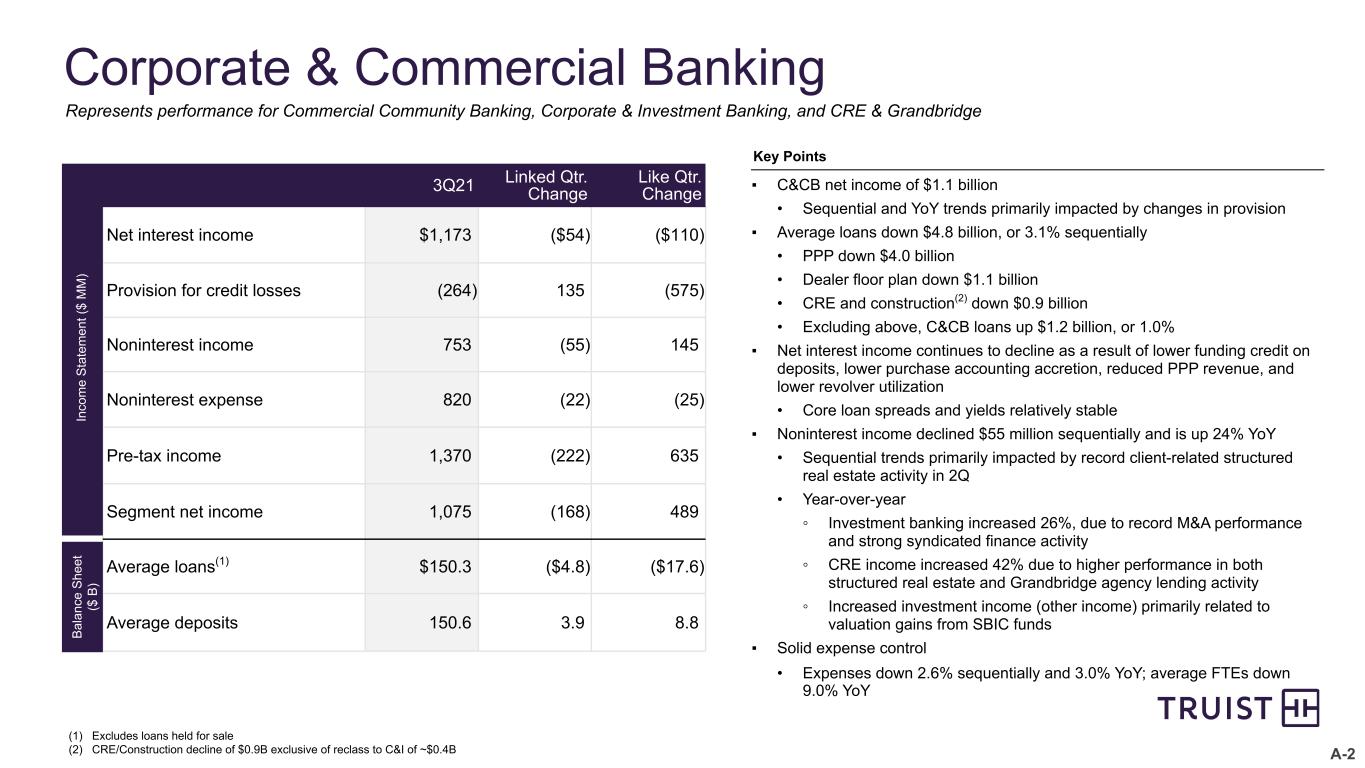
A-2 Corporate & Commercial Banking 3Q21 Linked Qtr. Change Like Qtr. Change Net interest income $1,173 ($54) ($110) Provision for credit losses (264) 135 (575) Noninterest income 753 (55) 145 Noninterest expense 820 (22) (25) Pre-tax income 1,370 (222) 635 Segment net income 1,075 (168) 489 Average loans(1) $150.3 ($4.8) ($17.6) Average deposits 150.6 3.9 8.8 In co m e S ta te m en t ( $ M M ) ▪ C&CB net income of $1.1 billion • Sequential and YoY trends primarily impacted by changes in provision ▪ Average loans down $4.8 billion, or 3.1% sequentially • PPP down $4.0 billion • Dealer floor plan down $1.1 billion • CRE and construction(2) down $0.9 billion • Excluding above, C&CB loans up $1.2 billion, or 1.0% ▪ Net interest income continues to decline as a result of lower funding credit on deposits, lower purchase accounting accretion, reduced PPP revenue, and lower revolver utilization • Core loan spreads and yields relatively stable ▪ Noninterest income declined $55 million sequentially and is up 24% YoY • Sequential trends primarily impacted by record client-related structured real estate activity in 2Q • Year-over-year ◦ Investment banking increased 26%, due to record M&A performance and strong syndicated finance activity ◦ CRE income increased 42% due to higher performance in both structured real estate and Grandbridge agency lending activity ◦ Increased investment income (other income) primarily related to valuation gains from SBIC funds ▪ Solid expense control • Expenses down 2.6% sequentially and 3.0% YoY; average FTEs down 9.0% YoY B al an ce S he et ($ B ) (1) Excludes loans held for sale (2) CRE/Construction decline of $0.9B exclusive of reclass to C&I of ~$0.4B Represents performance for Commercial Community Banking, Corporate & Investment Banking, and CRE & Grandbridge Key Points
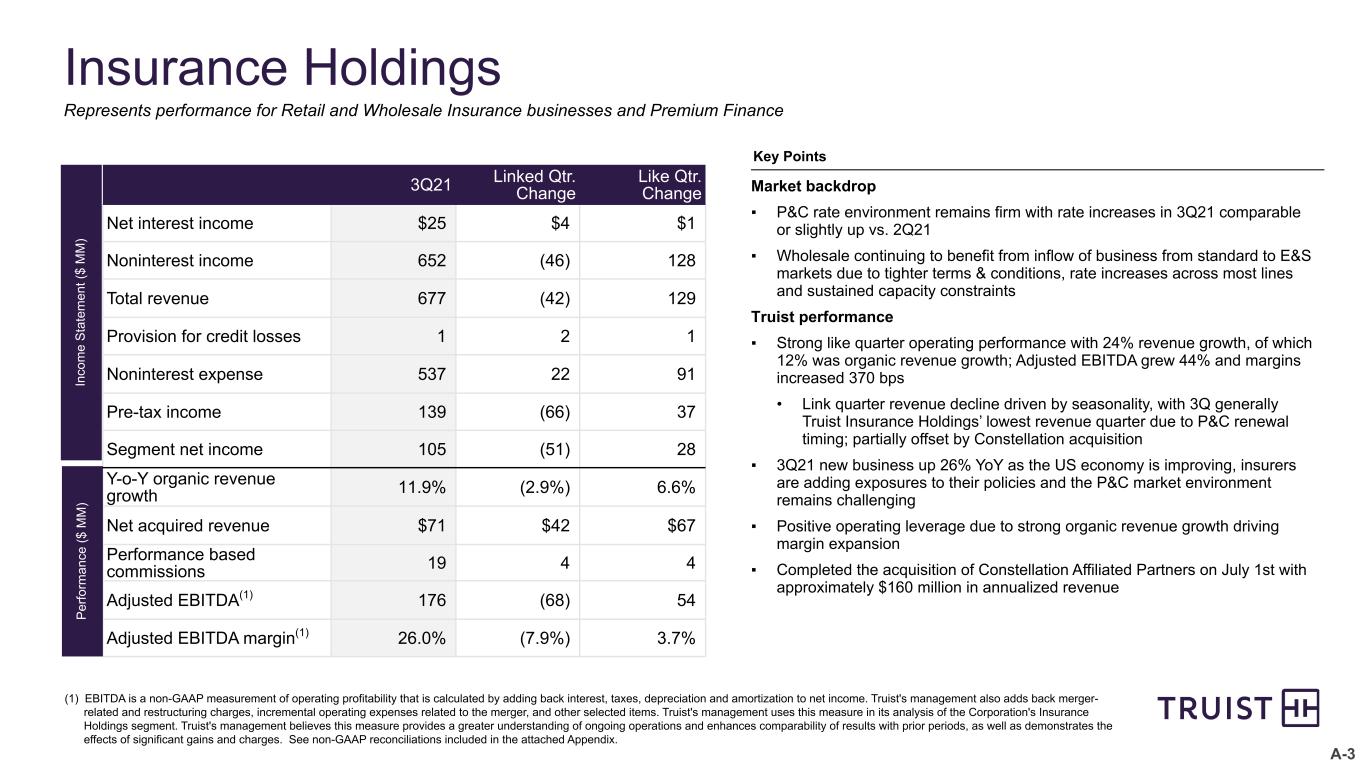
A-3 Insurance Holdings 3Q21 Linked Qtr. Change Like Qtr. Change Net interest income $25 $4 $1 Noninterest income 652 (46) 128 Total revenue 677 (42) 129 Provision for credit losses 1 2 1 Noninterest expense 537 22 91 Pre-tax income 139 (66) 37 Segment net income 105 (51) 28 Y-o-Y organic revenue growth 11.9% (2.9%) 6.6% Net acquired revenue $71 $42 $67 Performance based commissions 19 4 4 Adjusted EBITDA(1) 176 (68) 54 Adjusted EBITDA margin(1) 26.0% (7.9%) 3.7% In co m e S ta te m en t ( $ M M ) P er fo rm an ce ($ M M ) Market backdrop ▪ P&C rate environment remains firm with rate increases in 3Q21 comparable or slightly up vs. 2Q21 ▪ Wholesale continuing to benefit from inflow of business from standard to E&S markets due to tighter terms & conditions, rate increases across most lines and sustained capacity constraints Truist performance ▪ Strong like quarter operating performance with 24% revenue growth, of which 12% was organic revenue growth; Adjusted EBITDA grew 44% and margins increased 370 bps • Link quarter revenue decline driven by seasonality, with 3Q generally Truist Insurance Holdings’ lowest revenue quarter due to P&C renewal timing; partially offset by Constellation acquisition ▪ 3Q21 new business up 26% YoY as the US economy is improving, insurers are adding exposures to their policies and the P&C market environment remains challenging ▪ Positive operating leverage due to strong organic revenue growth driving margin expansion ▪ Completed the acquisition of Constellation Affiliated Partners on July 1st with approximately $160 million in annualized revenue (1) EBITDA is a non-GAAP measurement of operating profitability that is calculated by adding back interest, taxes, depreciation and amortization to net income. Truist's management also adds back merger- related and restructuring charges, incremental operating expenses related to the merger, and other selected items. Truist's management uses this measure in its analysis of the Corporation's Insurance Holdings segment. Truist's management believes this measure provides a greater understanding of ongoing operations and enhances comparability of results with prior periods, as well as demonstrates the effects of significant gains and charges. See non-GAAP reconciliations included in the attached Appendix. Represents performance for Retail and Wholesale Insurance businesses and Premium Finance Key Points
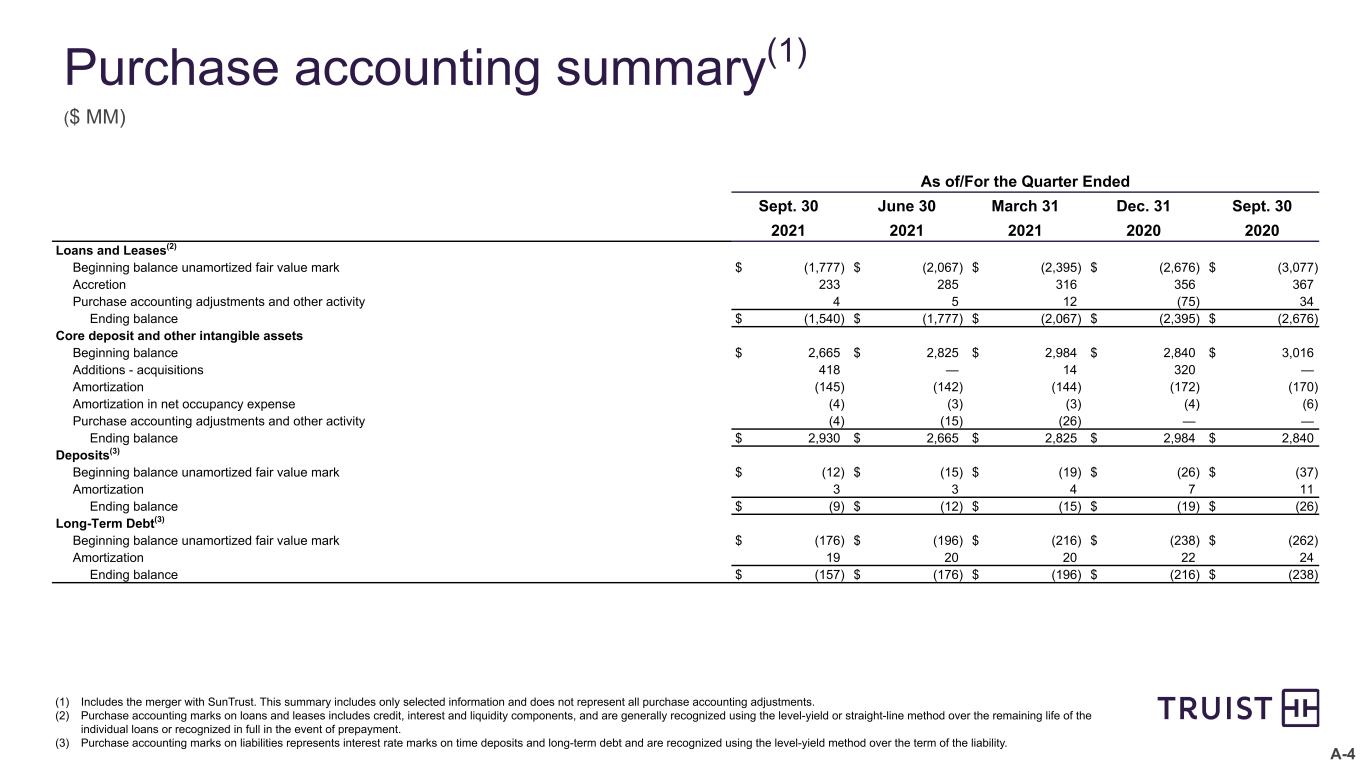
A-4 Purchase accounting summary(1) ($ MM) As of/For the Quarter Ended Sept. 30 June 30 March 31 Dec. 31 Sept. 30 2021 2021 2021 2020 2020 Loans and Leases(2) Beginning balance unamortized fair value mark $ (1,777) $ (2,067) $ (2,395) $ (2,676) $ (3,077) Accretion 233 285 316 356 367 Purchase accounting adjustments and other activity 4 5 12 (75) 34 Ending balance $ (1,540) $ (1,777) $ (2,067) $ (2,395) $ (2,676) Core deposit and other intangible assets Beginning balance $ 2,665 $ 2,825 $ 2,984 $ 2,840 $ 3,016 Additions - acquisitions 418 — 14 320 — Amortization (145) (142) (144) (172) (170) Amortization in net occupancy expense (4) (3) (3) (4) (6) Purchase accounting adjustments and other activity (4) (15) (26) — — Ending balance $ 2,930 $ 2,665 $ 2,825 $ 2,984 $ 2,840 Deposits(3) Beginning balance unamortized fair value mark $ (12) $ (15) $ (19) $ (26) $ (37) Amortization 3 3 4 7 11 Ending balance $ (9) $ (12) $ (15) $ (19) $ (26) Long-Term Debt(3) Beginning balance unamortized fair value mark $ (176) $ (196) $ (216) $ (238) $ (262) Amortization 19 20 20 22 24 Ending balance $ (157) $ (176) $ (196) $ (216) $ (238) (1) Includes the merger with SunTrust. This summary includes only selected information and does not represent all purchase accounting adjustments. (2) Purchase accounting marks on loans and leases includes credit, interest and liquidity components, and are generally recognized using the level-yield or straight-line method over the remaining life of the individual loans or recognized in full in the event of prepayment. (3) Purchase accounting marks on liabilities represents interest rate marks on time deposits and long-term debt and are recognized using the level-yield method over the term of the liability.
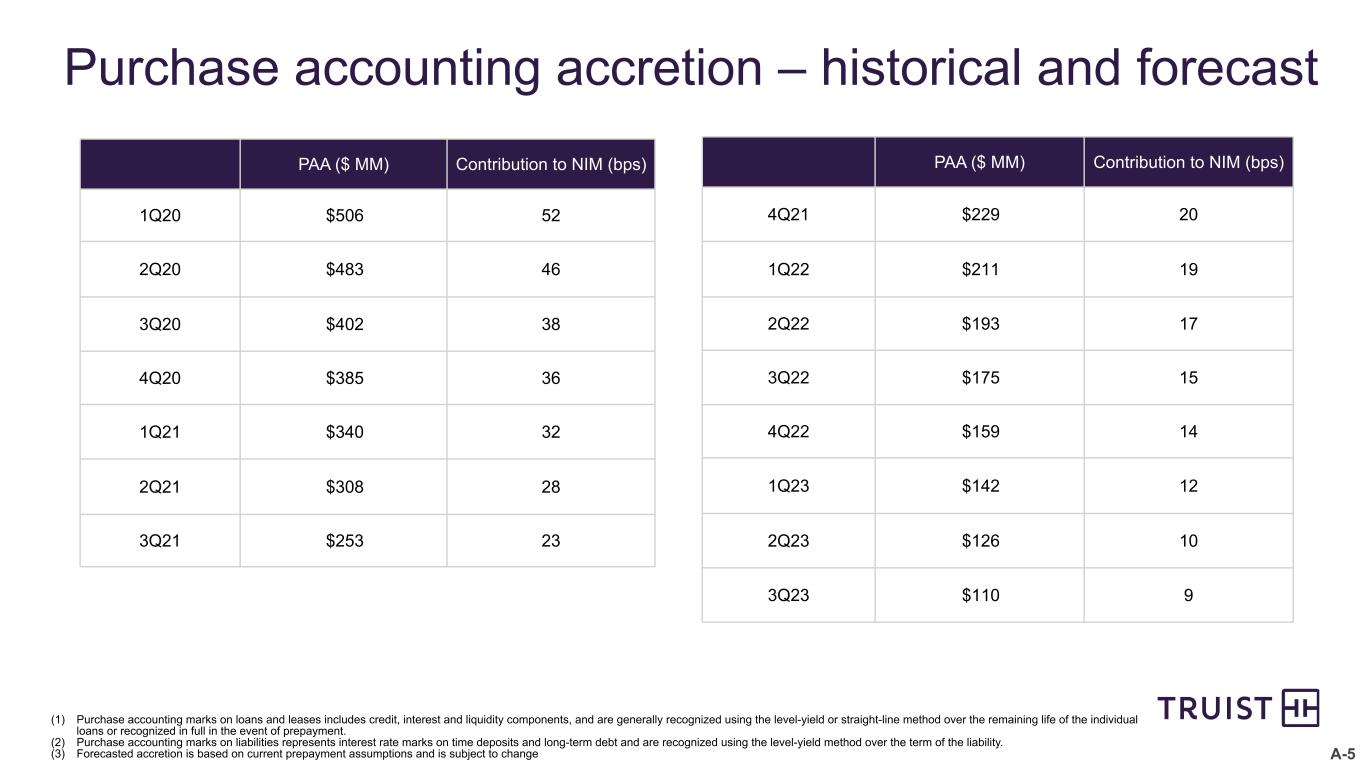
A-5 Purchase accounting accretion – historical and forecast PAA ($ MM) Contribution to NIM (bps) 4Q21 $229 20 1Q22 $211 19 2Q22 $193 17 3Q22 $175 15 4Q22 $159 14 1Q23 $142 12 2Q23 $126 10 3Q23 $110 9 PAA ($ MM) Contribution to NIM (bps) 1Q20 $506 52 2Q20 $483 46 3Q20 $402 38 4Q20 $385 36 1Q21 $340 32 2Q21 $308 28 3Q21 $253 23 (1) Purchase accounting marks on loans and leases includes credit, interest and liquidity components, and are generally recognized using the level-yield or straight-line method over the remaining life of the individual loans or recognized in full in the event of prepayment. (2) Purchase accounting marks on liabilities represents interest rate marks on time deposits and long-term debt and are recognized using the level-yield method over the term of the liability. (3) Forecasted accretion is based on current prepayment assumptions and is subject to change
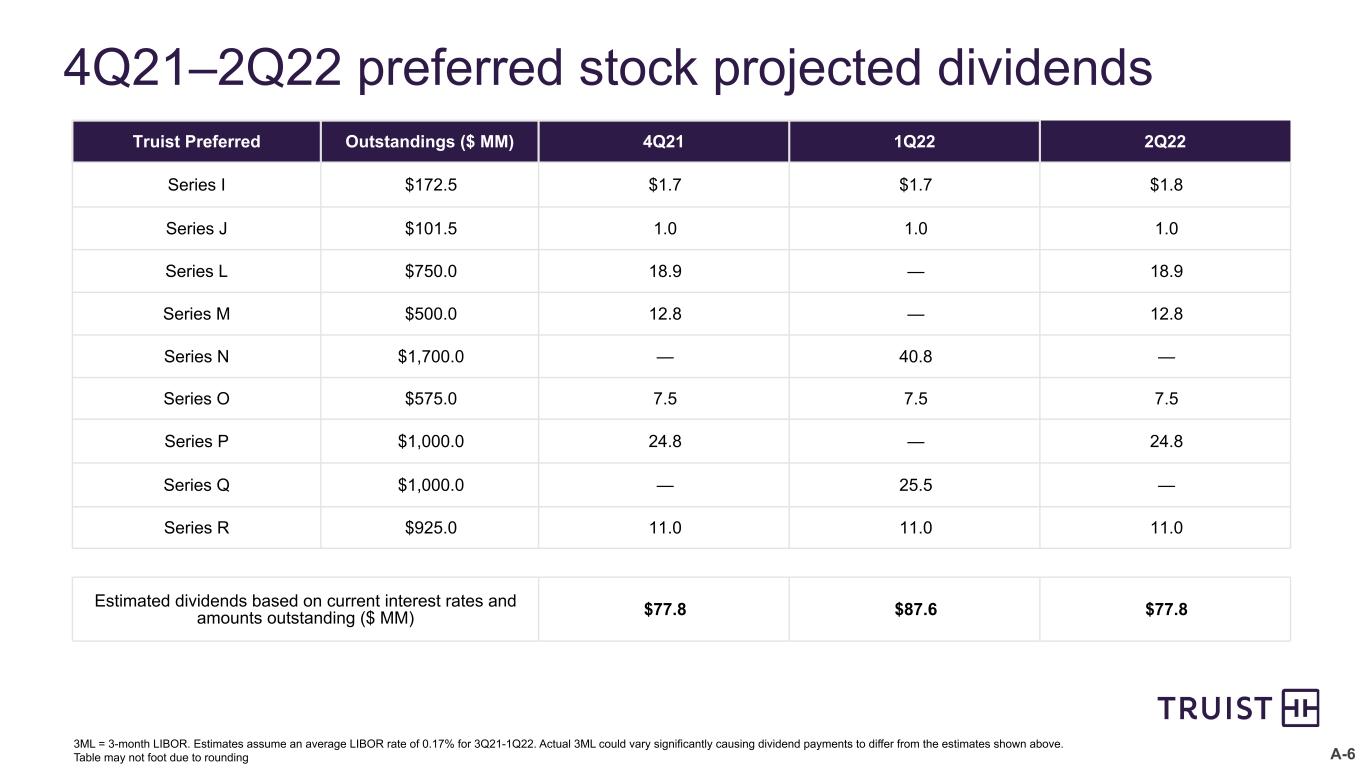
A-6 4Q21–2Q22 preferred stock projected dividends 3ML = 3-month LIBOR. Estimates assume an average LIBOR rate of 0.17% for 3Q21-1Q22. Actual 3ML could vary significantly causing dividend payments to differ from the estimates shown above. Table may not foot due to rounding Truist Preferred Outstandings ($ MM) 4Q21 1Q22 2Q22 Series I $172.5 $1.7 $1.7 $1.8 Series J $101.5 1.0 1.0 1.0 Series L $750.0 18.9 — 18.9 Series M $500.0 12.8 — 12.8 Series N $1,700.0 — 40.8 — Series O $575.0 7.5 7.5 7.5 Series P $1,000.0 24.8 — 24.8 Series Q $1,000.0 — 25.5 — Series R $925.0 11.0 11.0 11.0 Estimated dividends based on current interest rates and amounts outstanding ($ MM) $77.8 $87.6 $77.8

Non-GAAP Reconciliations
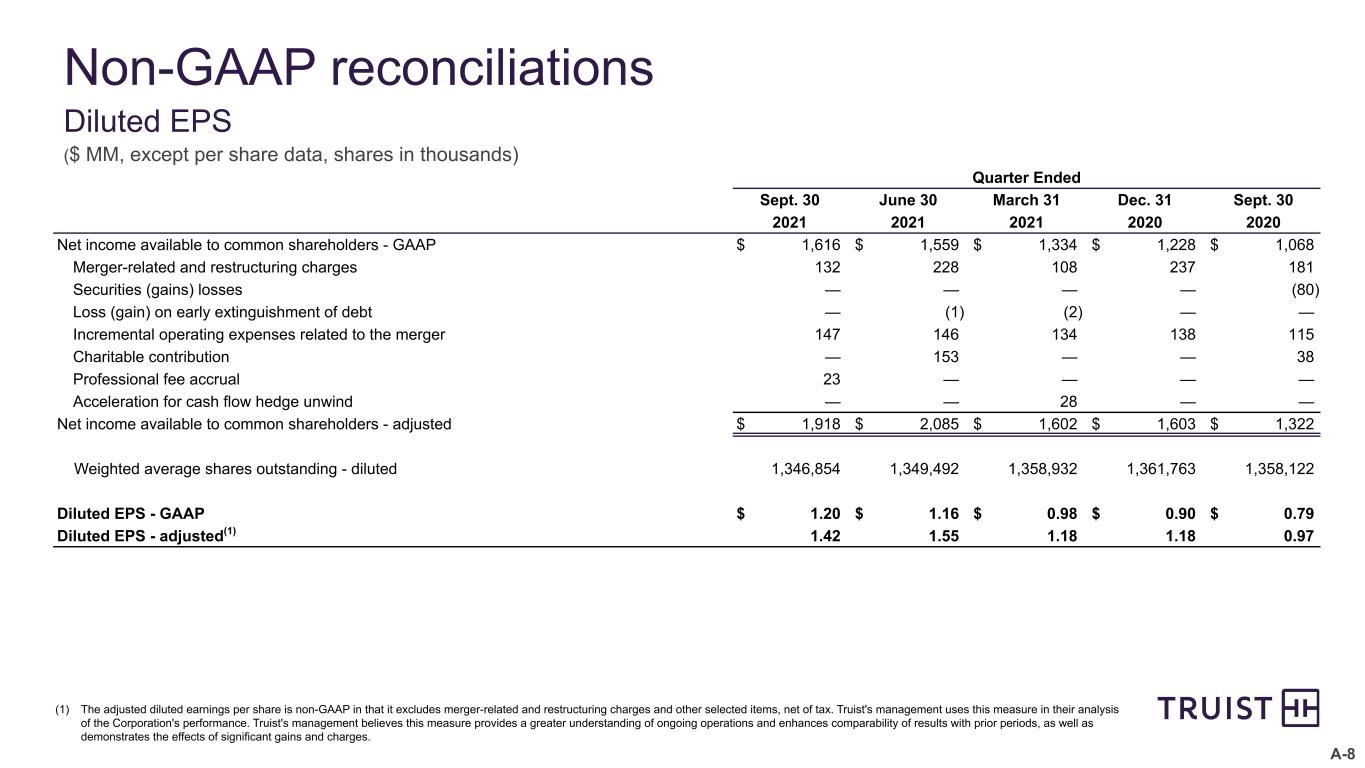
A-8 Quarter Ended Sept. 30 June 30 March 31 Dec. 31 Sept. 30 2021 2021 2021 2020 2020 Net income available to common shareholders - GAAP $ 1,616 $ 1,559 $ 1,334 $ 1,228 $ 1,068 Merger-related and restructuring charges 132 228 108 237 181 Securities (gains) losses — — — — (80) Loss (gain) on early extinguishment of debt — (1) (2) — — Incremental operating expenses related to the merger 147 146 134 138 115 Charitable contribution — 153 — — 38 Professional fee accrual 23 — — — — Acceleration for cash flow hedge unwind — — 28 — — Net income available to common shareholders - adjusted $ 1,918 $ 2,085 $ 1,602 $ 1,603 $ 1,322 Weighted average shares outstanding - diluted 1,346,854 1,349,492 1,358,932 1,361,763 1,358,122 Diluted EPS - GAAP $ 1.20 $ 1.16 $ 0.98 $ 0.90 $ 0.79 Diluted EPS - adjusted(1) 1.42 1.55 1.18 1.18 0.97 Non-GAAP reconciliations Diluted EPS ($ MM, except per share data, shares in thousands) (1) The adjusted diluted earnings per share is non-GAAP in that it excludes merger-related and restructuring charges and other selected items, net of tax. Truist's management uses this measure in their analysis of the Corporation's performance. Truist's management believes this measure provides a greater understanding of ongoing operations and enhances comparability of results with prior periods, as well as demonstrates the effects of significant gains and charges.

A-9 Non-GAAP reconciliations Efficiency ratio ($ MM) (1) Revenue is defined as net interest income plus noninterest income. (2) The adjusted efficiency ratio is non-GAAP in that it excludes securities gains (losses), amortization of intangible assets, merger-related and restructuring charges, and other selected items. Truist's management uses this measure in their analysis of the Corporation's performance. Truist's management believes this measure provides a greater understanding of ongoing operations and enhances comparability of results with prior periods, as well as demonstrates the effects of significant gains and charges. Quarter Ended Sept. 30 June 30 March 31 Dec. 31 Sept. 30 2021 2021 2021 2020 2020 Efficiency ratio numerator - noninterest expense - GAAP $ 3,795 $ 4,011 $ 3,610 $ 3,833 $ 3,755 Merger-related and restructuring charges, net (172) (297) (141) (308) (236) Gain (loss) on early extinguishment of debt — — 3 — — Incremental operating expense related to the merger (191) (190) (175) (179) (152) Amortization of intangibles (145) (142) (144) (172) (170) Charitable contribution — (200) — — (50) Professional fee accrual (30) — — — — Acceleration for cash flow hedge unwind — — (36) — — Efficiency ratio numerator - adjusted $ 3,257 $ 3,182 $ 3,117 $ 3,174 $ 3,147 Efficiency ratio denominator - revenue(1) - GAAP $ 5,598 $ 5,650 $ 5,482 $ 5,651 $ 5,572 Taxable equivalent adjustment 28 28 28 28 29 Securities (gains) losses — — — — (104) Gains on divestiture of certain businesses — — (37) — — Efficiency ratio denominator - adjusted $ 5,626 $ 5,678 $ 5,473 $ 5,679 $ 5,497 Efficiency ratio - GAAP 67.8 % 71.0 % 65.8 % 67.8 % 67.4 % Efficiency ratio - adjusted(2) 57.9 56.1 56.9 55.9 57.3
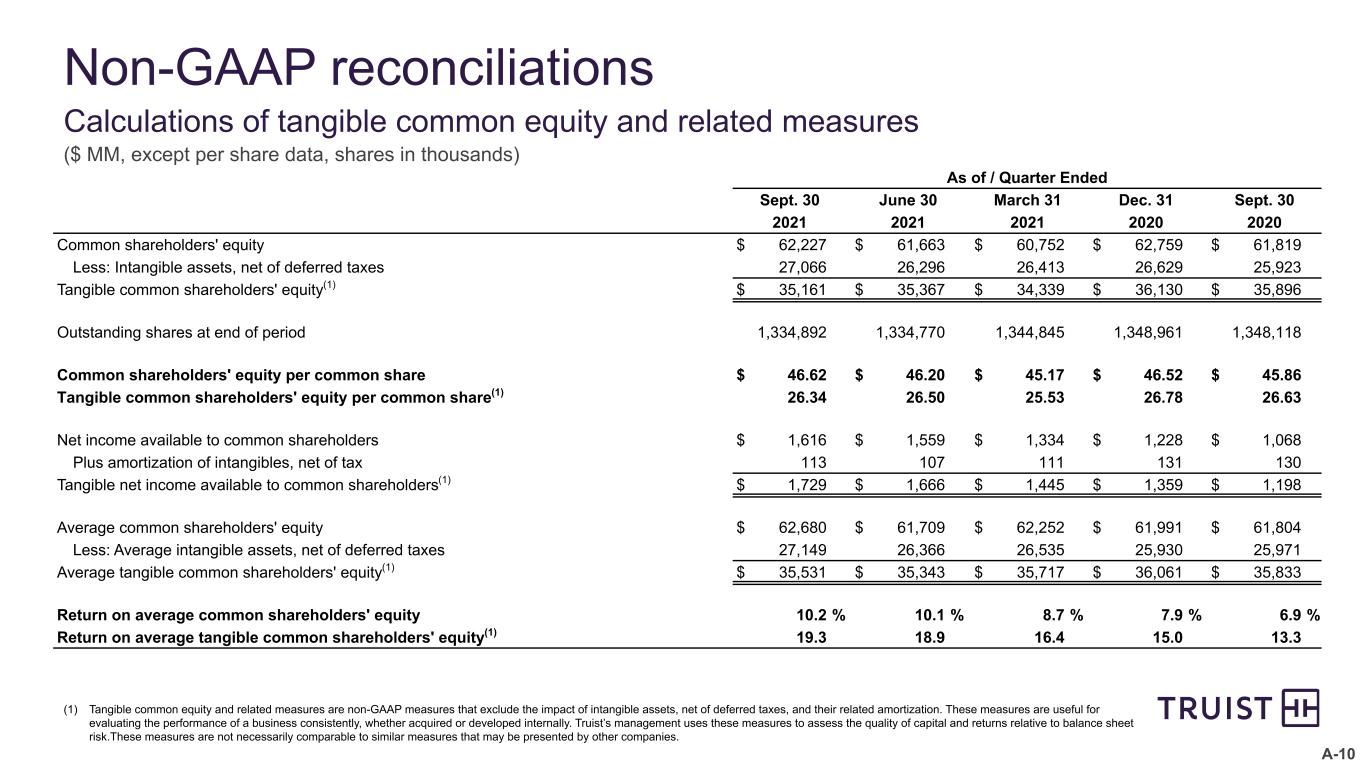
A-10 Non-GAAP reconciliations Calculations of tangible common equity and related measures ($ MM, except per share data, shares in thousands) (1) Tangible common equity and related measures are non-GAAP measures that exclude the impact of intangible assets, net of deferred taxes, and their related amortization. These measures are useful for evaluating the performance of a business consistently, whether acquired or developed internally. Truist’s management uses these measures to assess the quality of capital and returns relative to balance sheet risk.These measures are not necessarily comparable to similar measures that may be presented by other companies. As of / Quarter Ended Sept. 30 June 30 March 31 Dec. 31 Sept. 30 2021 2021 2021 2020 2020 Common shareholders' equity $ 62,227 $ 61,663 $ 60,752 $ 62,759 $ 61,819 Less: Intangible assets, net of deferred taxes 27,066 26,296 26,413 26,629 25,923 Tangible common shareholders' equity(1) $ 35,161 $ 35,367 $ 34,339 $ 36,130 $ 35,896 Outstanding shares at end of period 1,334,892 1,334,770 1,344,845 1,348,961 1,348,118 Common shareholders' equity per common share $ 46.62 $ 46.20 $ 45.17 $ 46.52 $ 45.86 Tangible common shareholders' equity per common share(1) 26.34 26.50 25.53 26.78 26.63 Net income available to common shareholders $ 1,616 $ 1,559 $ 1,334 $ 1,228 $ 1,068 Plus amortization of intangibles, net of tax 113 107 111 131 130 Tangible net income available to common shareholders(1) $ 1,729 $ 1,666 $ 1,445 $ 1,359 $ 1,198 Average common shareholders' equity $ 62,680 $ 61,709 $ 62,252 $ 61,991 $ 61,804 Less: Average intangible assets, net of deferred taxes 27,149 26,366 26,535 25,930 25,971 Average tangible common shareholders' equity(1) $ 35,531 $ 35,343 $ 35,717 $ 36,061 $ 35,833 Return on average common shareholders' equity 10.2 % 10.1 % 8.7 % 7.9 % 6.9 % Return on average tangible common shareholders' equity(1) 19.3 18.9 16.4 15.0 13.3
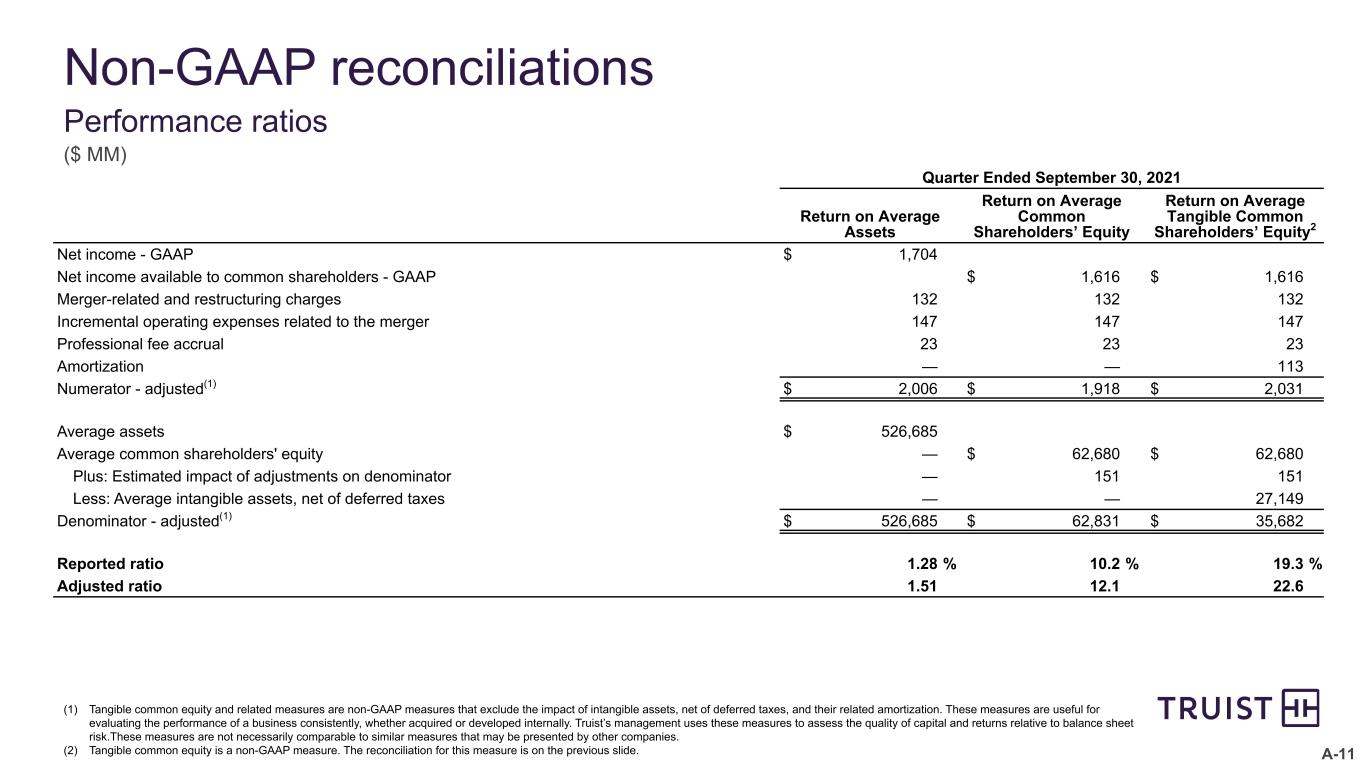
A-11 Non-GAAP reconciliations Performance ratios ($ MM) (1) Tangible common equity and related measures are non-GAAP measures that exclude the impact of intangible assets, net of deferred taxes, and their related amortization. These measures are useful for evaluating the performance of a business consistently, whether acquired or developed internally. Truist’s management uses these measures to assess the quality of capital and returns relative to balance sheet risk.These measures are not necessarily comparable to similar measures that may be presented by other companies. (2) Tangible common equity is a non-GAAP measure. The reconciliation for this measure is on the previous slide. Quarter Ended September 30, 2021 Return on Average Assets Return on Average Common Shareholders’ Equity Return on Average Tangible Common Shareholders’ Equity2 Net income - GAAP $ 1,704 Net income available to common shareholders - GAAP $ 1,616 $ 1,616 Merger-related and restructuring charges 132 132 132 Incremental operating expenses related to the merger 147 147 147 Professional fee accrual 23 23 23 Amortization — — 113 Numerator - adjusted(1) $ 2,006 $ 1,918 $ 2,031 Average assets $ 526,685 Average common shareholders' equity — $ 62,680 $ 62,680 Plus: Estimated impact of adjustments on denominator — 151 151 Less: Average intangible assets, net of deferred taxes — — 27,149 Denominator - adjusted(1) $ 526,685 $ 62,831 $ 35,682 Reported ratio 1.28 % 10.2 % 19.3 % Adjusted ratio 1.51 12.1 22.6
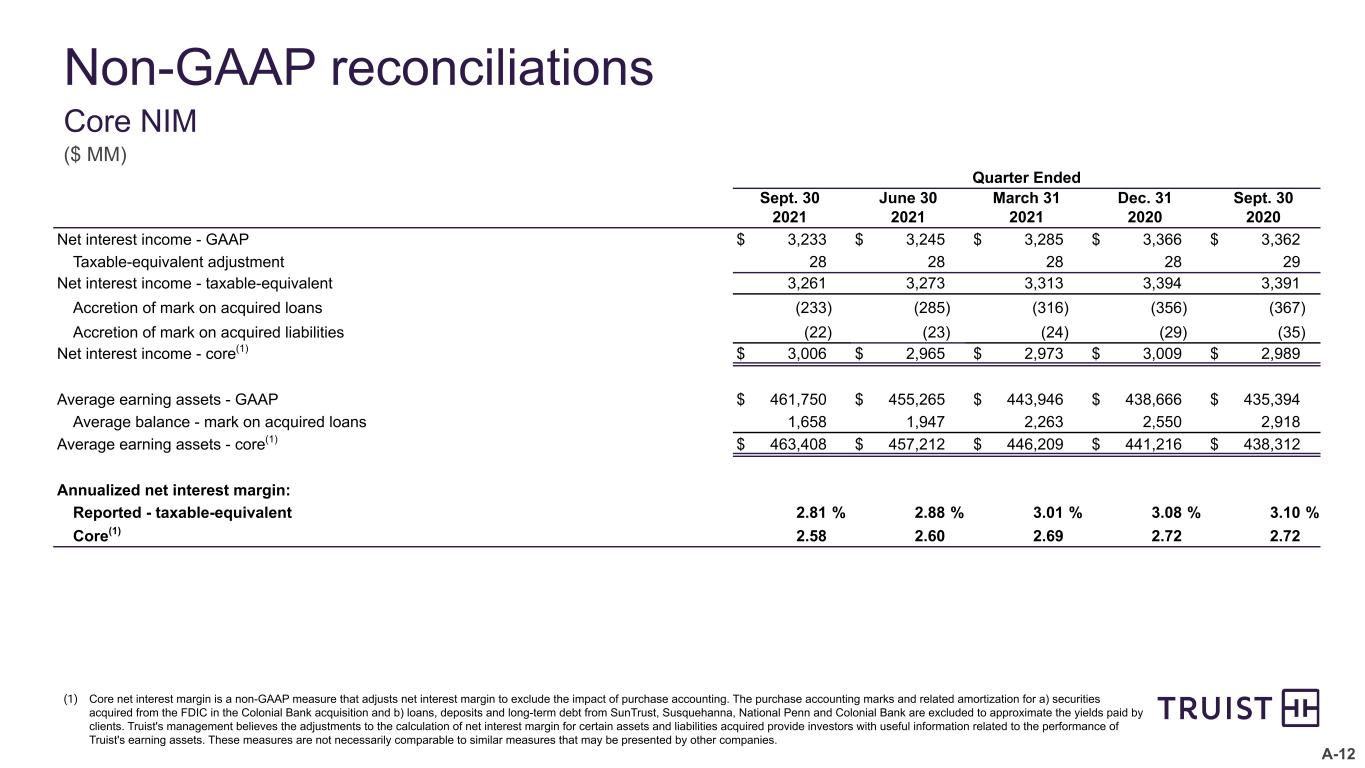
A-12 Quarter Ended Sept. 30 June 30 March 31 Dec. 31 Sept. 30 2021 2021 2021 2020 2020 Net interest income - GAAP $ 3,233 $ 3,245 $ 3,285 $ 3,366 $ 3,362 Taxable-equivalent adjustment 28 28 28 28 29 Net interest income - taxable-equivalent 3,261 3,273 3,313 3,394 3,391 Accretion of mark on acquired loans (233) (285) (316) (356) (367) Accretion of mark on acquired liabilities (22) (23) (24) (29) (35) Net interest income - core(1) $ 3,006 $ 2,965 $ 2,973 $ 3,009 $ 2,989 Average earning assets - GAAP $ 461,750 $ 455,265 $ 443,946 $ 438,666 $ 435,394 Average balance - mark on acquired loans 1,658 1,947 2,263 2,550 2,918 Average earning assets - core(1) $ 463,408 $ 457,212 $ 446,209 $ 441,216 $ 438,312 Annualized net interest margin: Reported - taxable-equivalent 2.81 % 2.88 % 3.01 % 3.08 % 3.10 % Core(1) 2.58 2.60 2.69 2.72 2.72 Non-GAAP reconciliations Core NIM ($ MM) (1) Core net interest margin is a non-GAAP measure that adjusts net interest margin to exclude the impact of purchase accounting. The purchase accounting marks and related amortization for a) securities acquired from the FDIC in the Colonial Bank acquisition and b) loans, deposits and long-term debt from SunTrust, Susquehanna, National Penn and Colonial Bank are excluded to approximate the yields paid by clients. Truist's management believes the adjustments to the calculation of net interest margin for certain assets and liabilities acquired provide investors with useful information related to the performance of Truist's earning assets. These measures are not necessarily comparable to similar measures that may be presented by other companies.
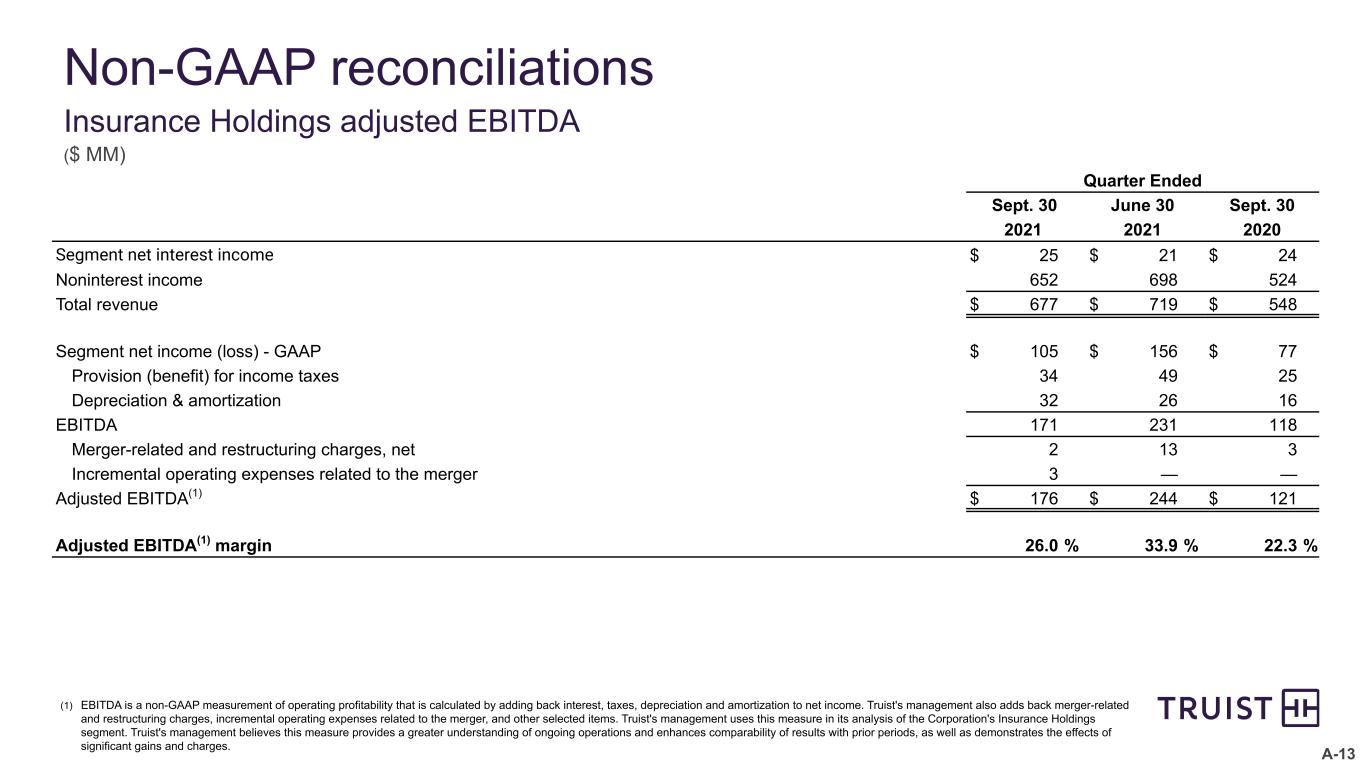
A-13 Non-GAAP reconciliations Insurance Holdings adjusted EBITDA ($ MM) (1) EBITDA is a non-GAAP measurement of operating profitability that is calculated by adding back interest, taxes, depreciation and amortization to net income. Truist's management also adds back merger-related and restructuring charges, incremental operating expenses related to the merger, and other selected items. Truist's management uses this measure in its analysis of the Corporation's Insurance Holdings segment. Truist's management believes this measure provides a greater understanding of ongoing operations and enhances comparability of results with prior periods, as well as demonstrates the effects of significant gains and charges. Quarter Ended Sept. 30 June 30 Sept. 30 2021 2021 2020 Segment net interest income $ 25 $ 21 $ 24 Noninterest income 652 698 524 Total revenue $ 677 $ 719 $ 548 Segment net income (loss) - GAAP $ 105 $ 156 $ 77 Provision (benefit) for income taxes 34 49 25 Depreciation & amortization 32 26 16 EBITDA 171 231 118 Merger-related and restructuring charges, net 2 13 3 Incremental operating expenses related to the merger 3 — — Adjusted EBITDA(1) $ 176 $ 244 $ 121 Adjusted EBITDA(1) margin 26.0 % 33.9 % 22.3 %
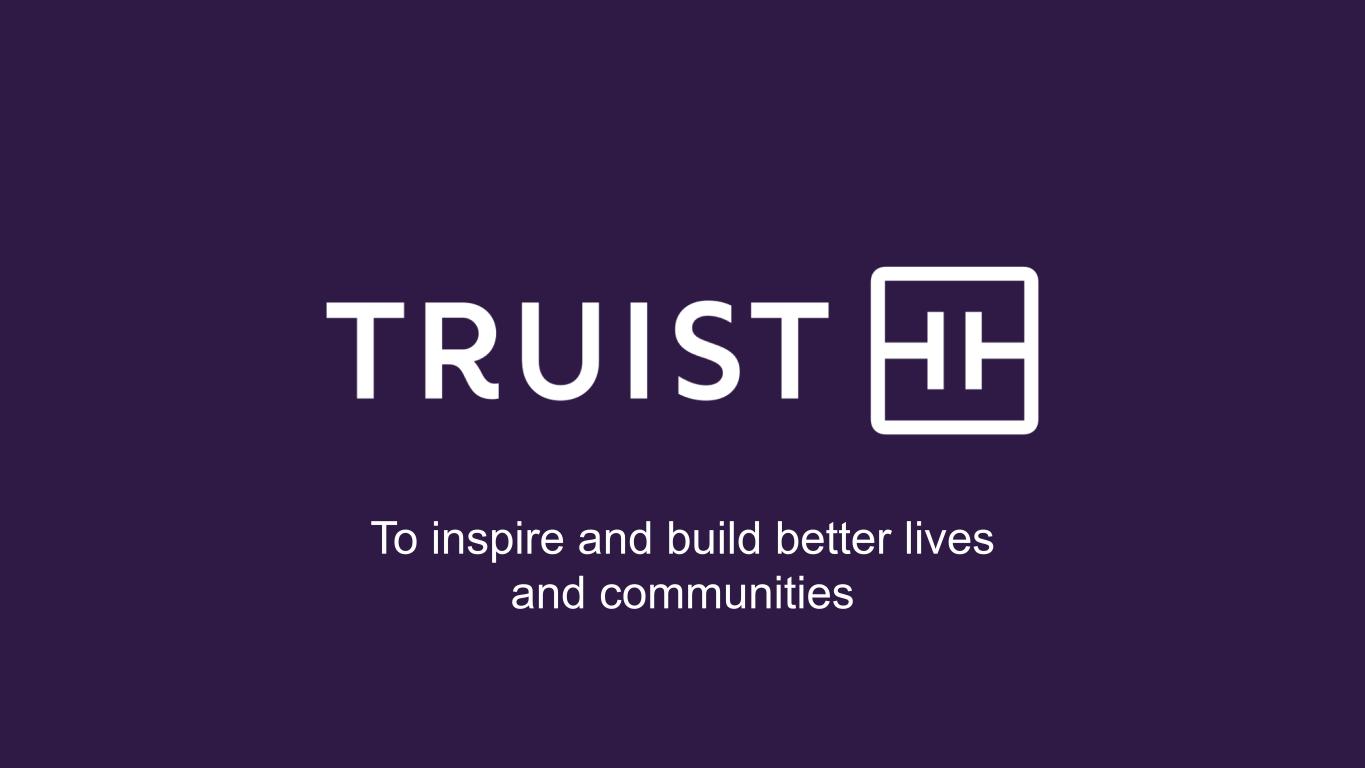
To inspire and build better lives and communities








































